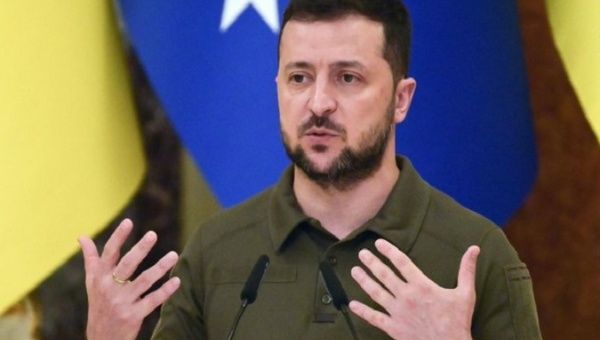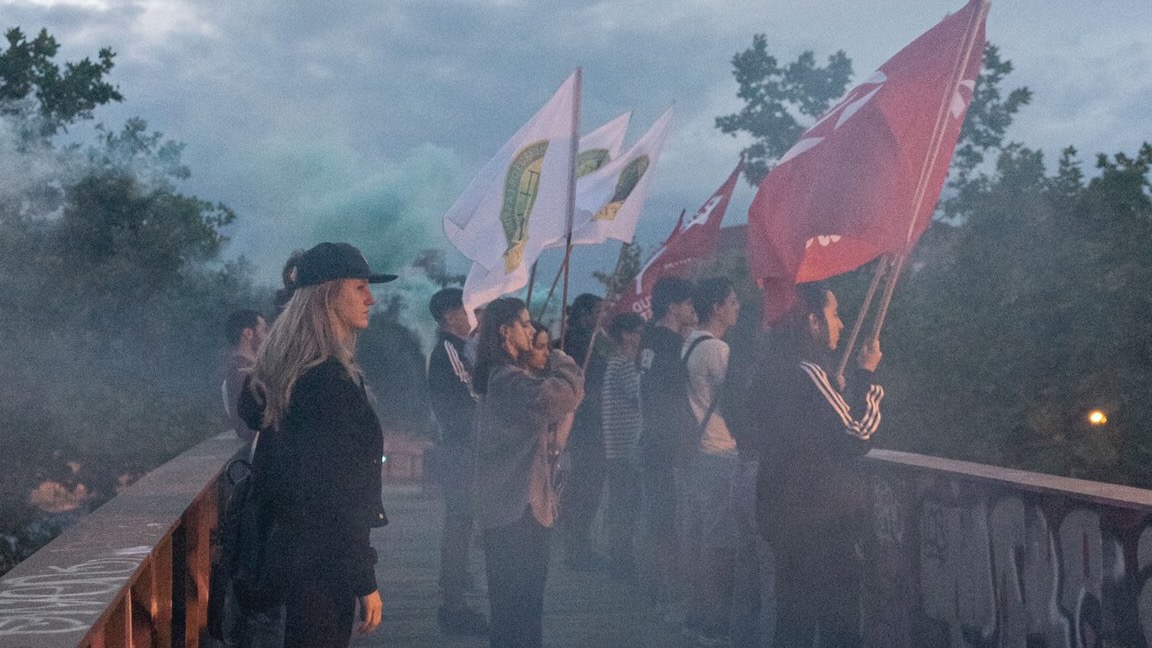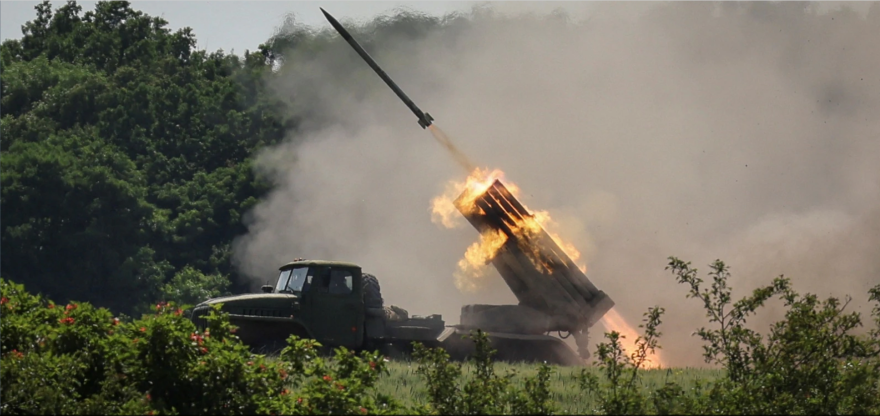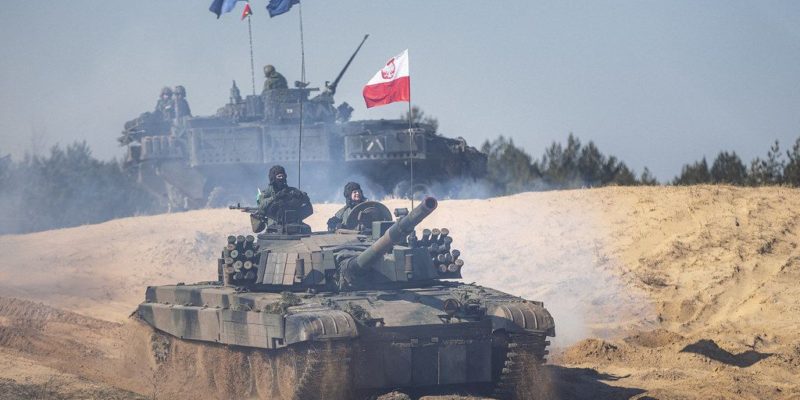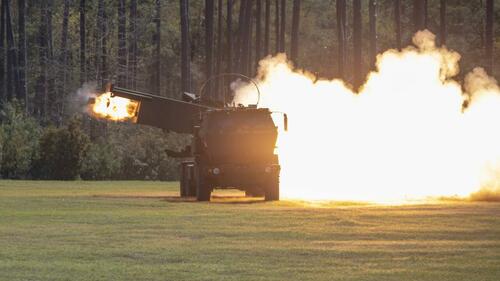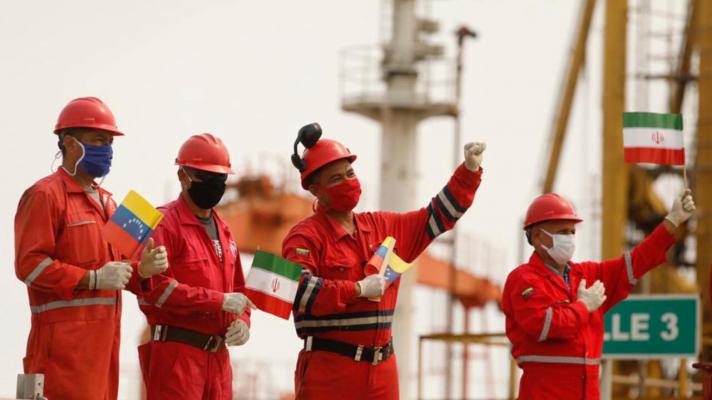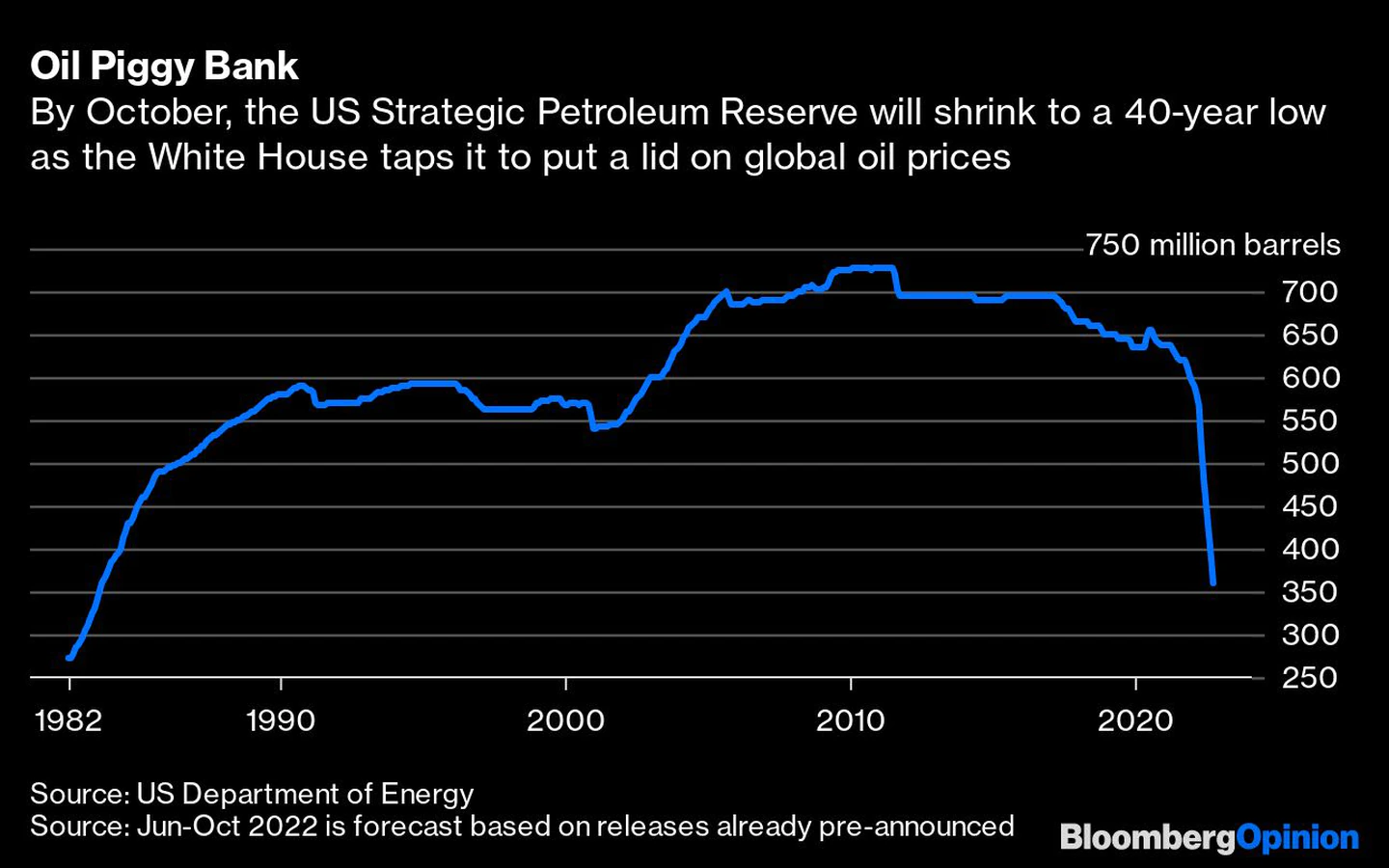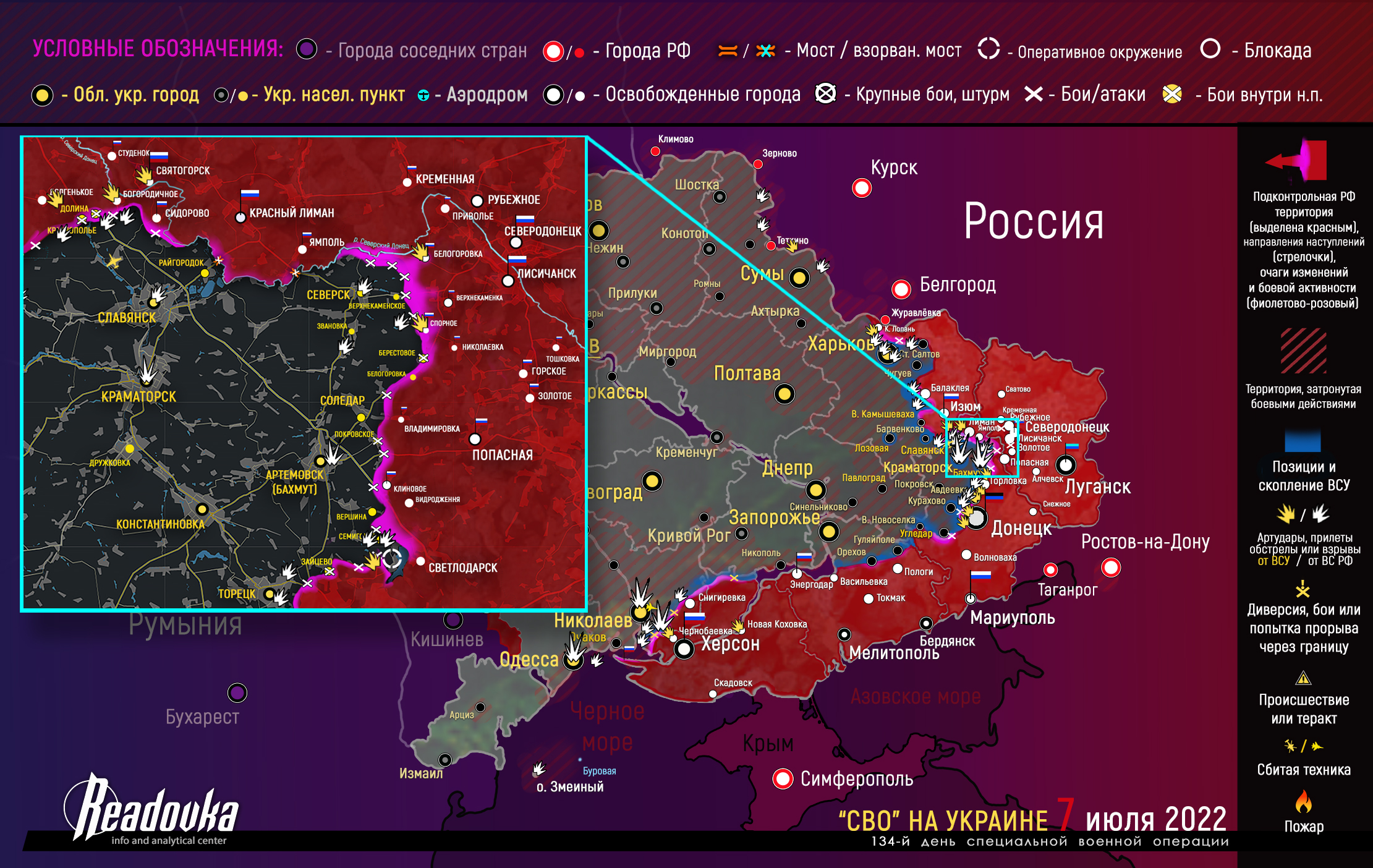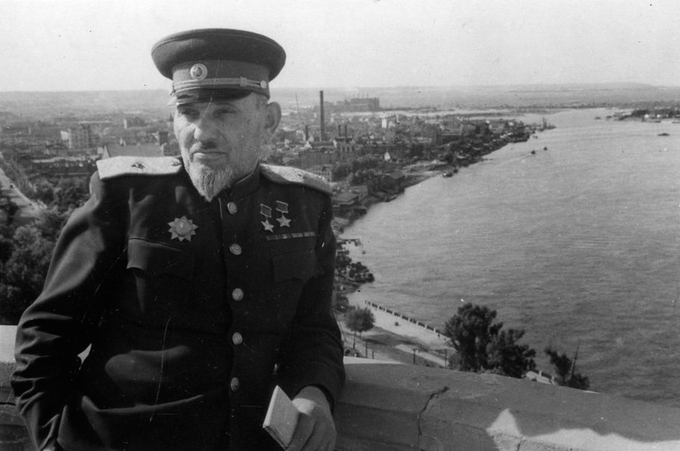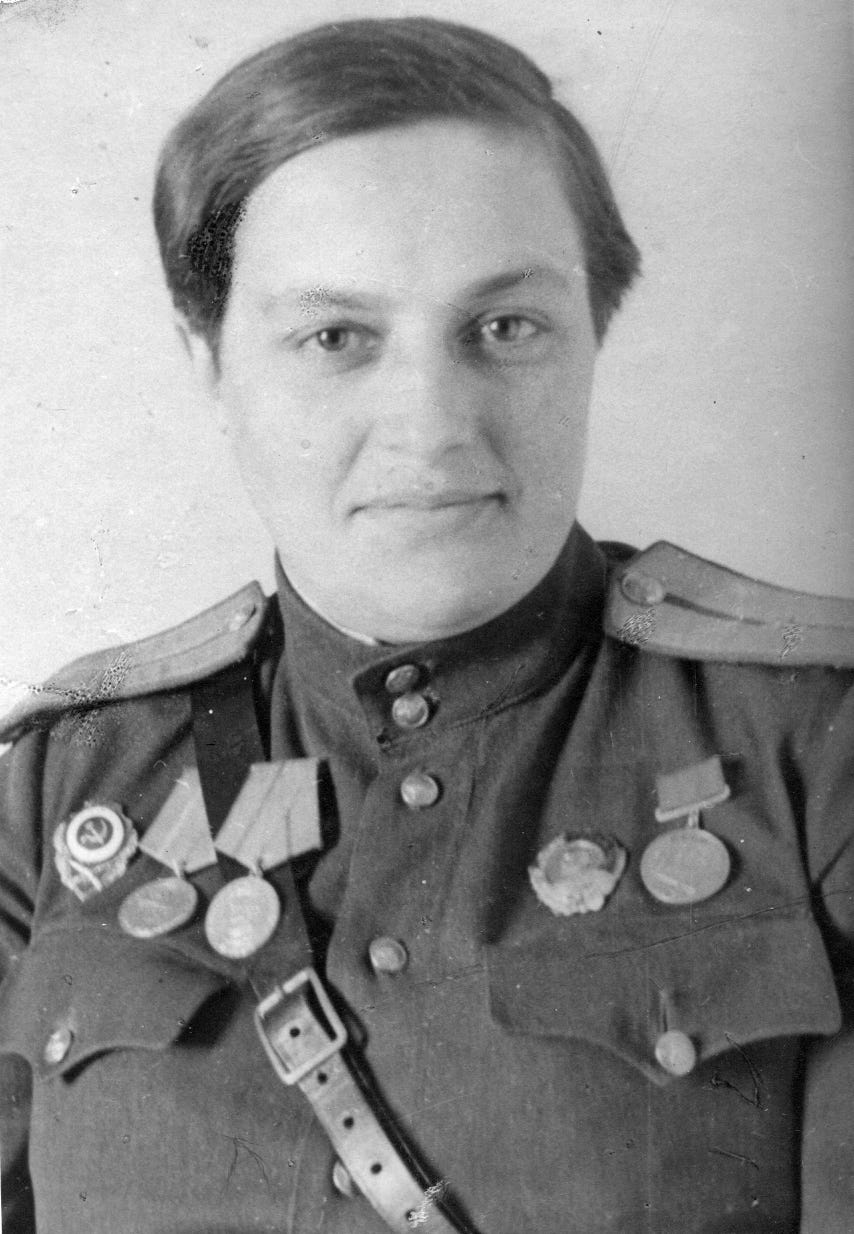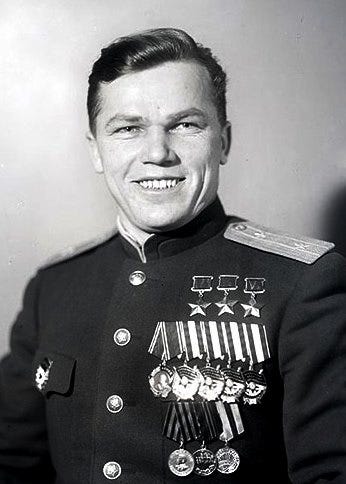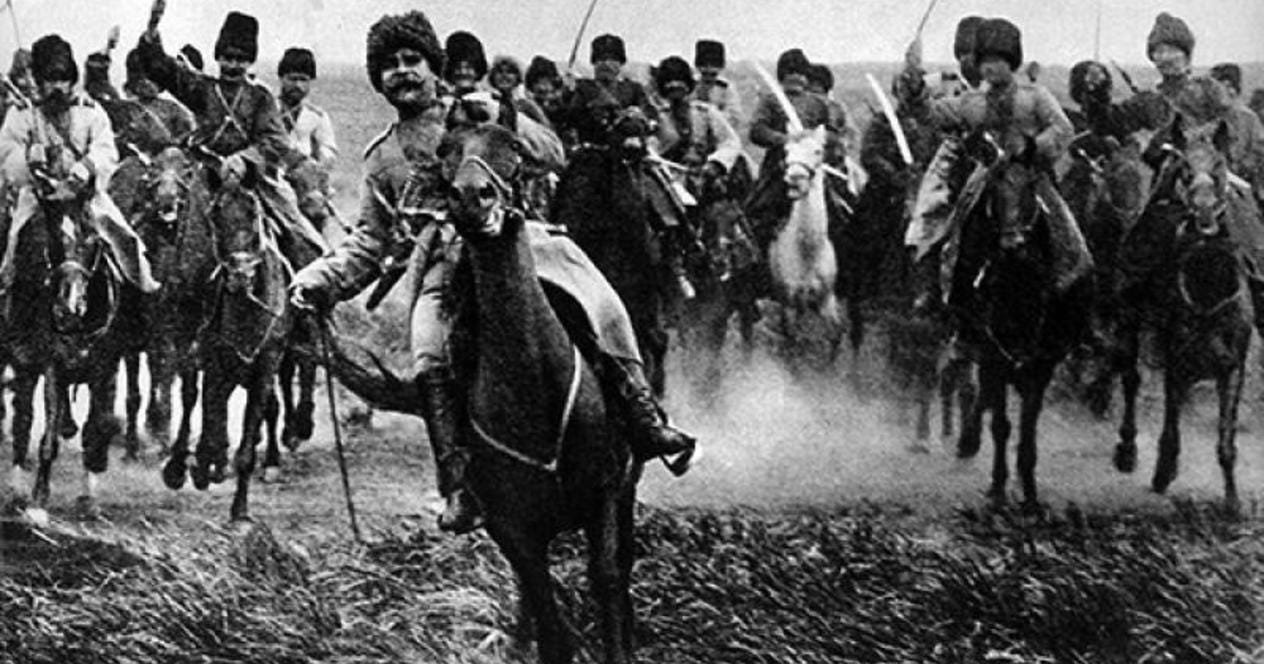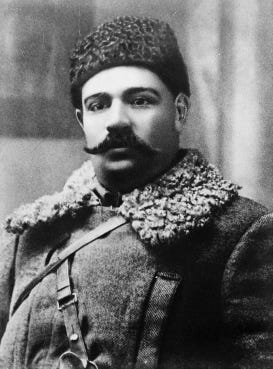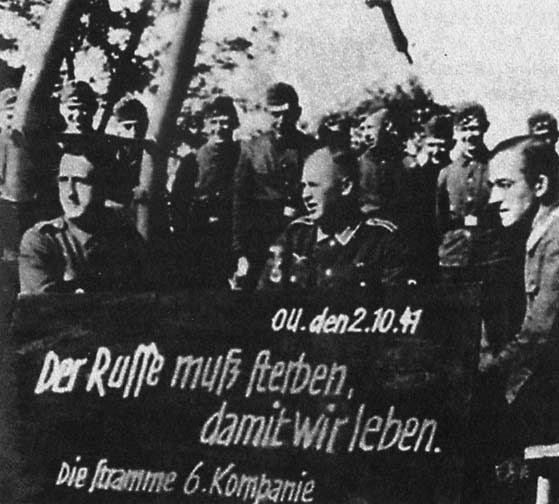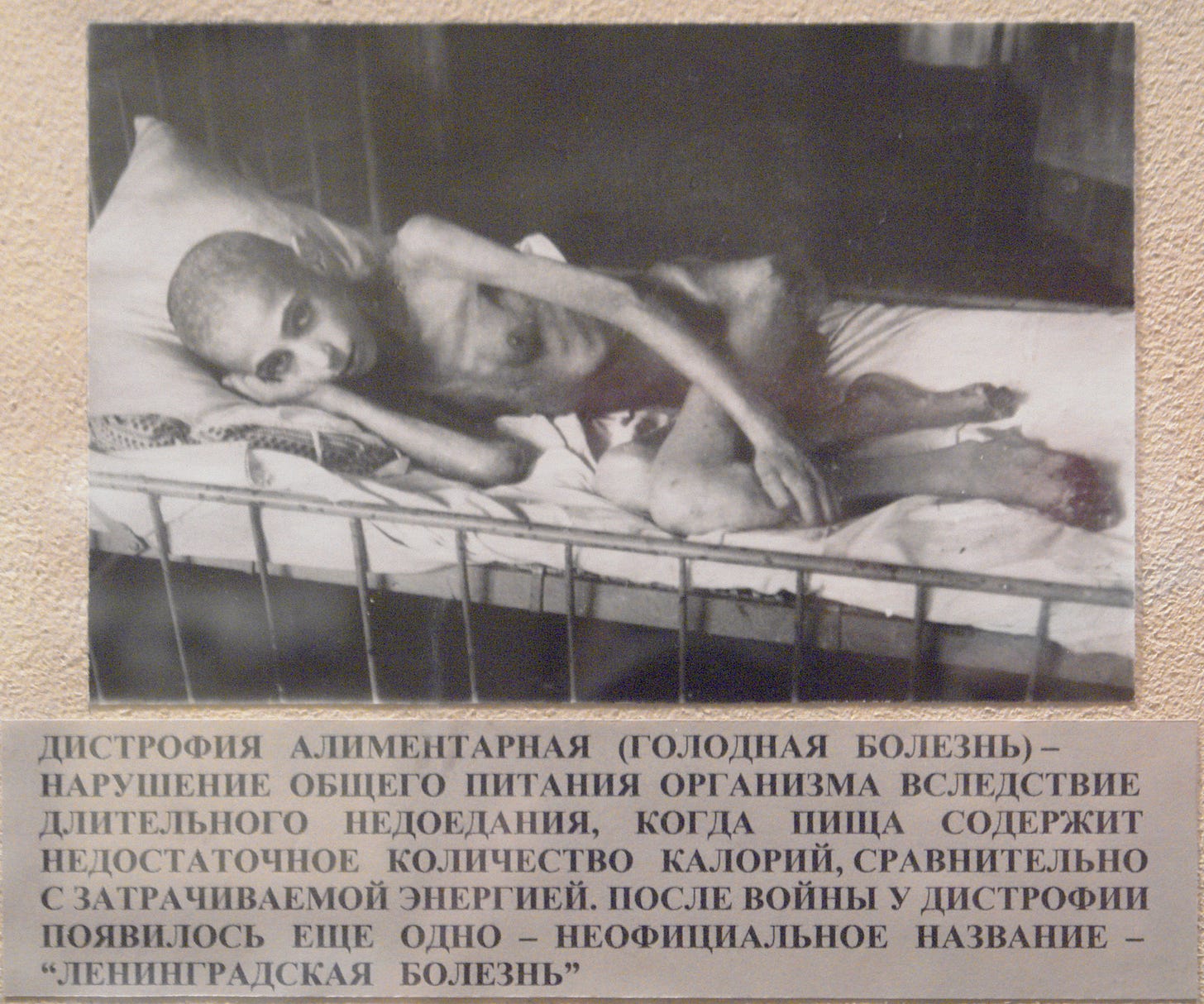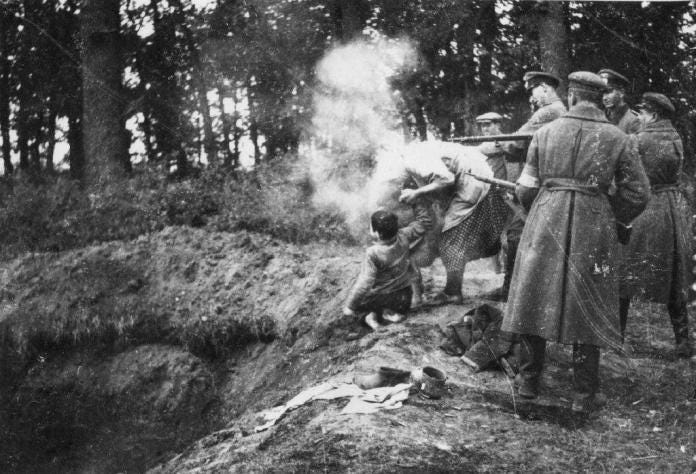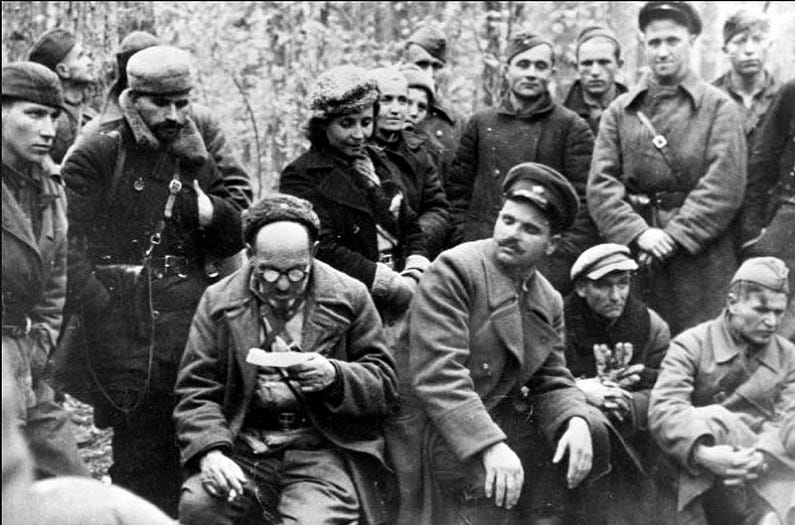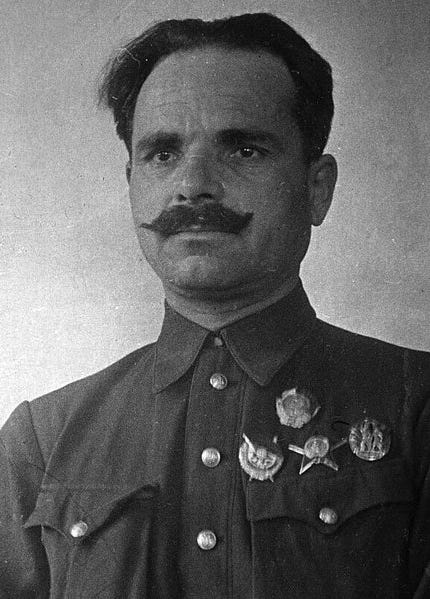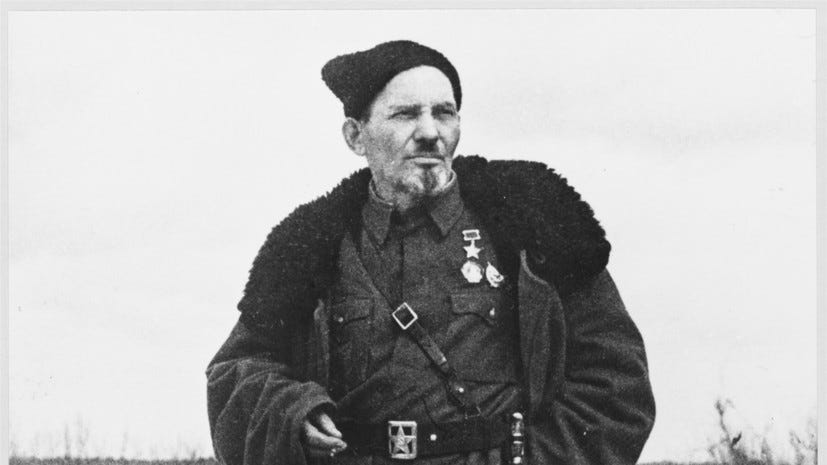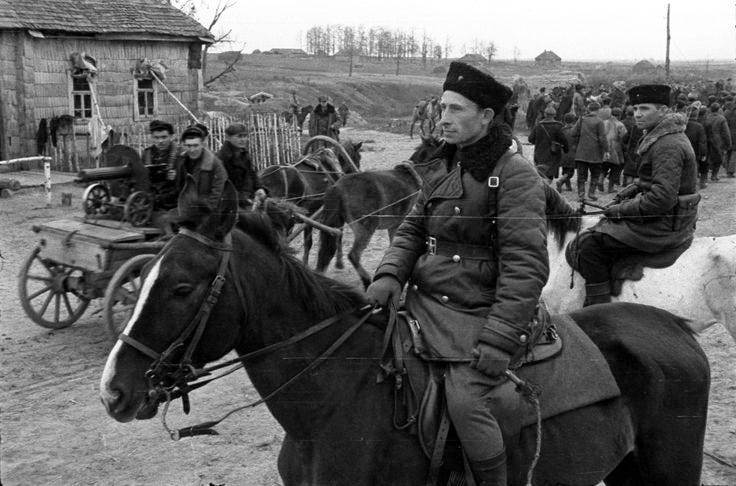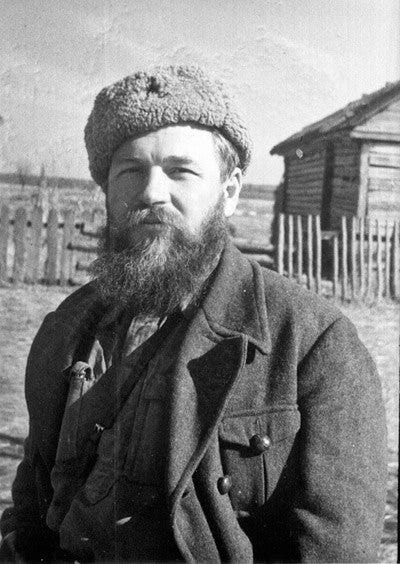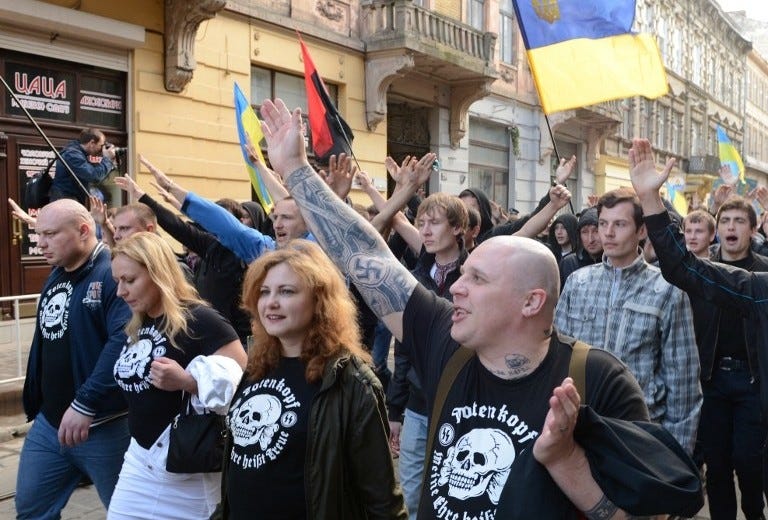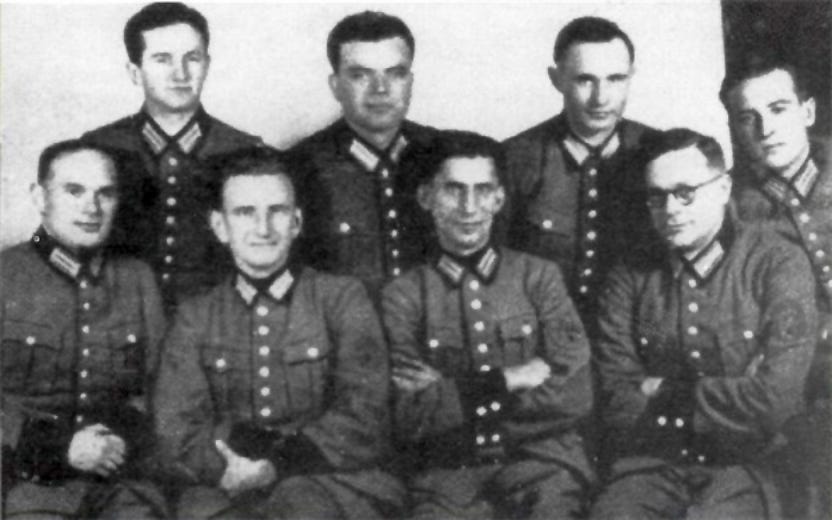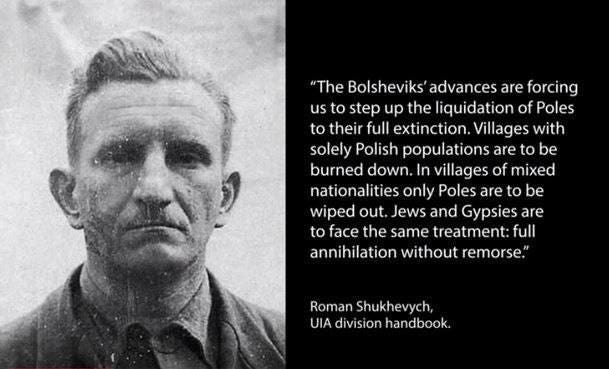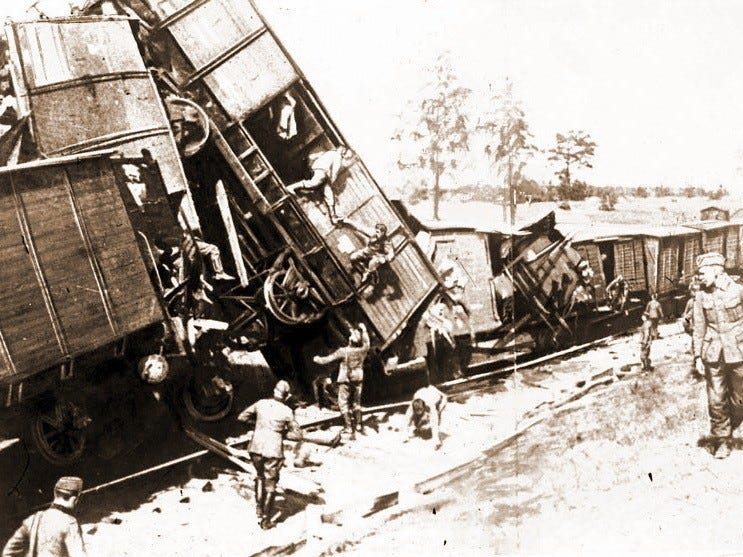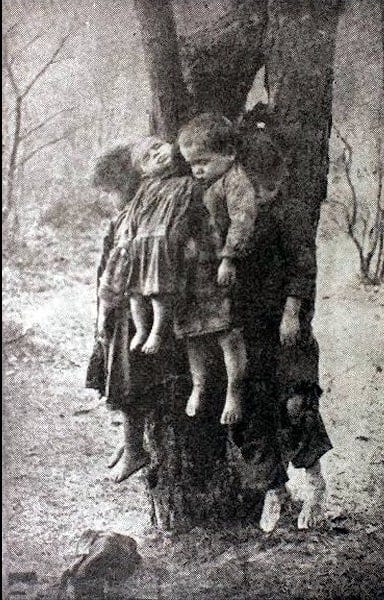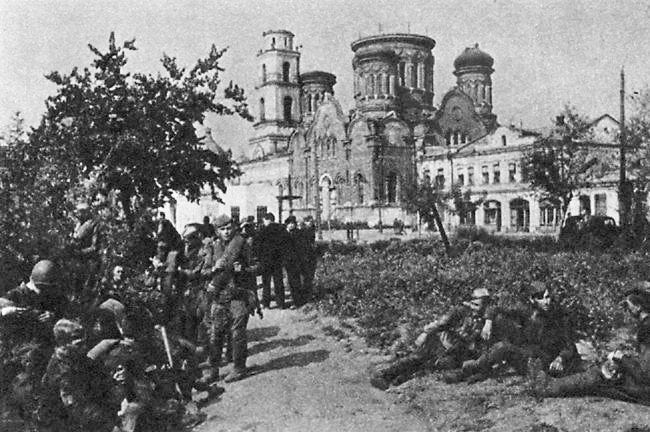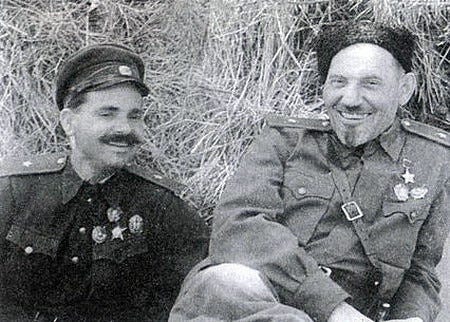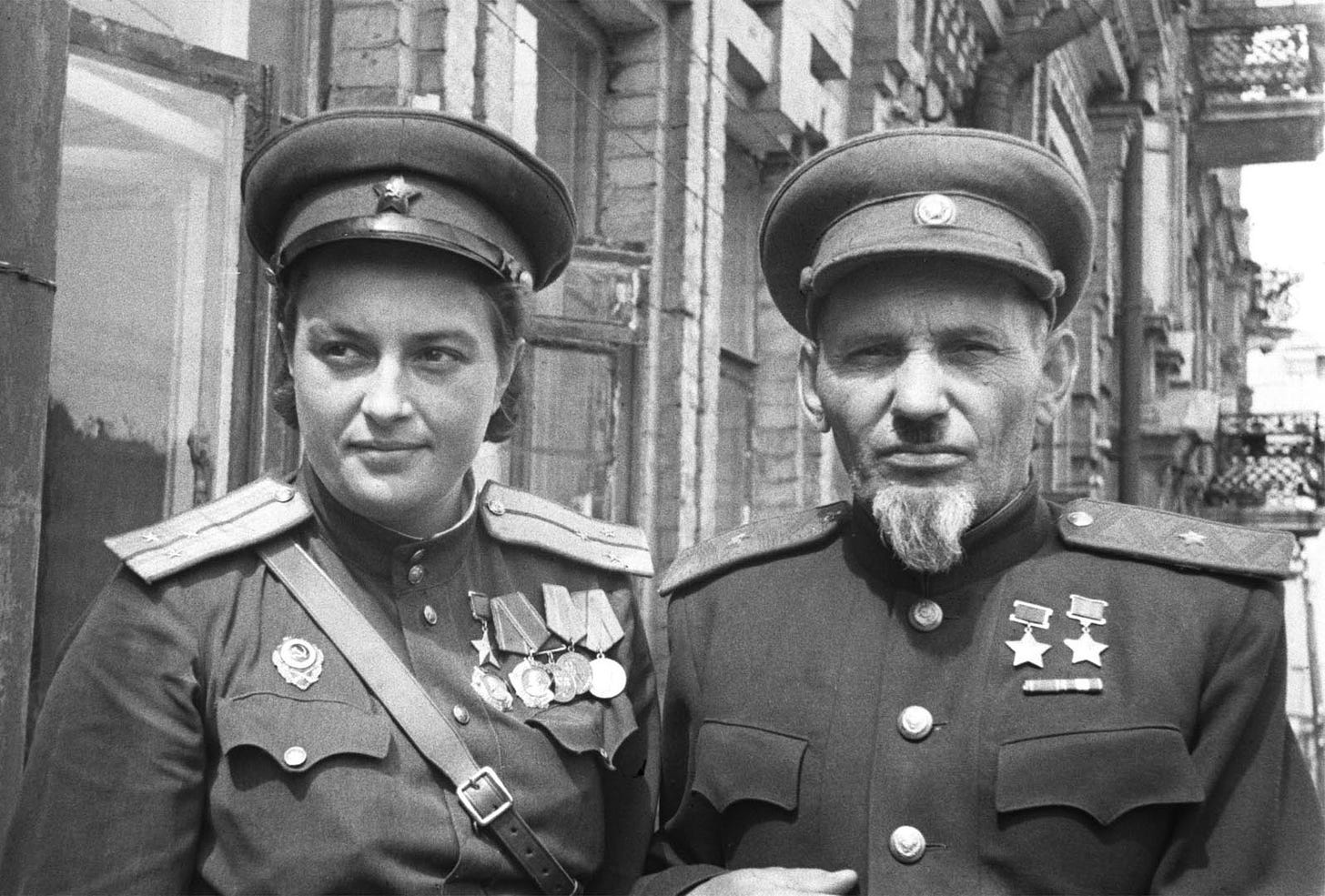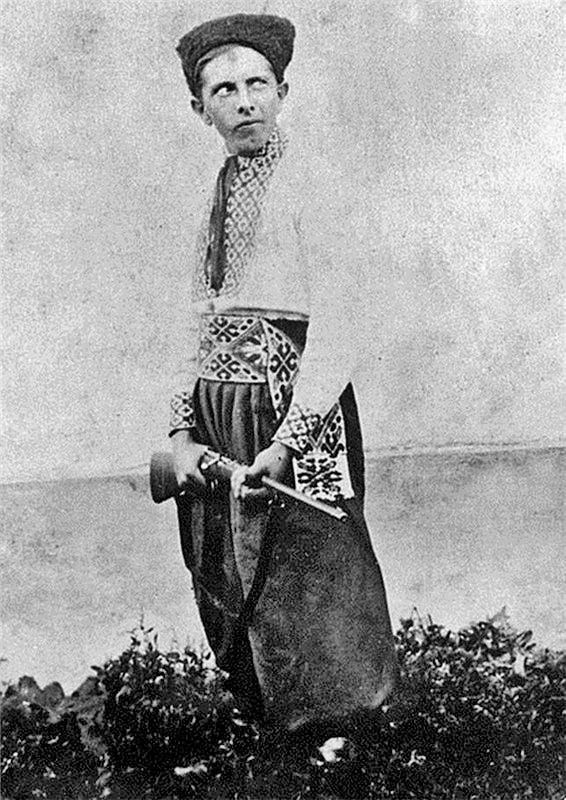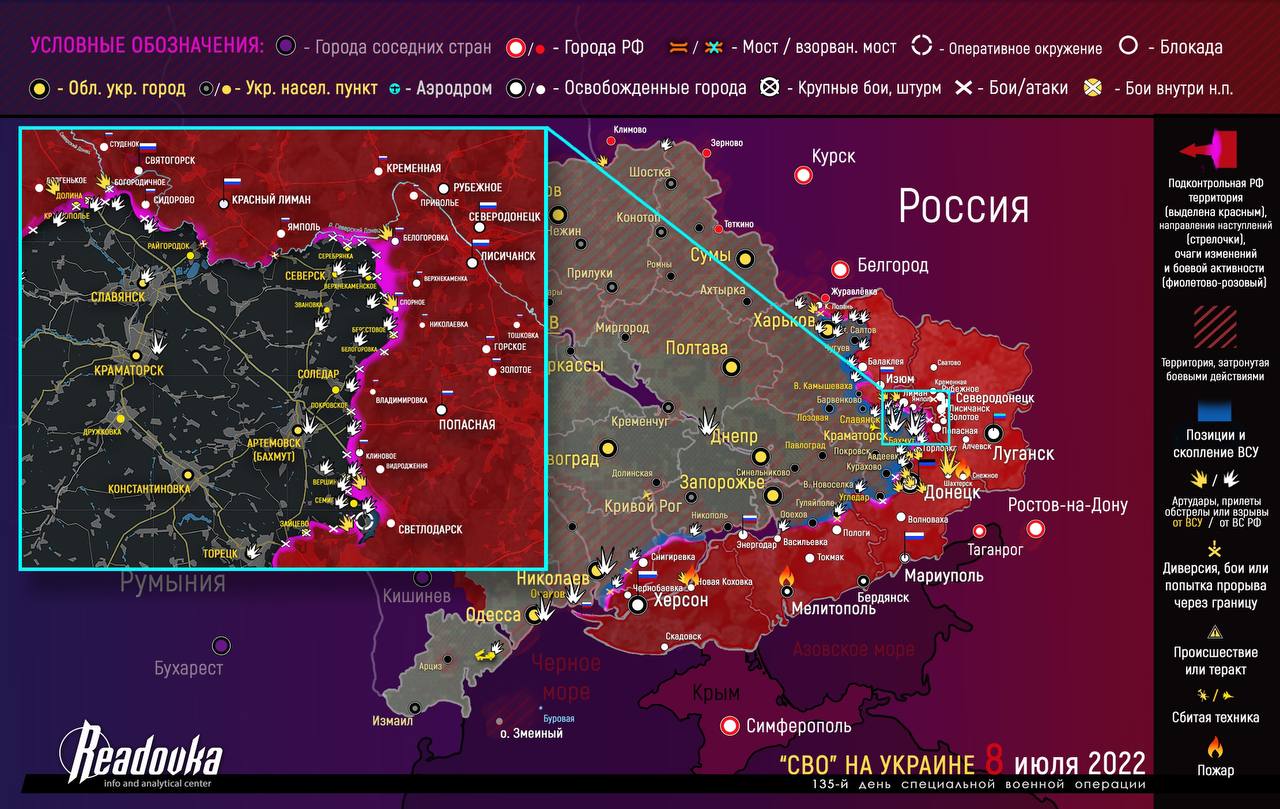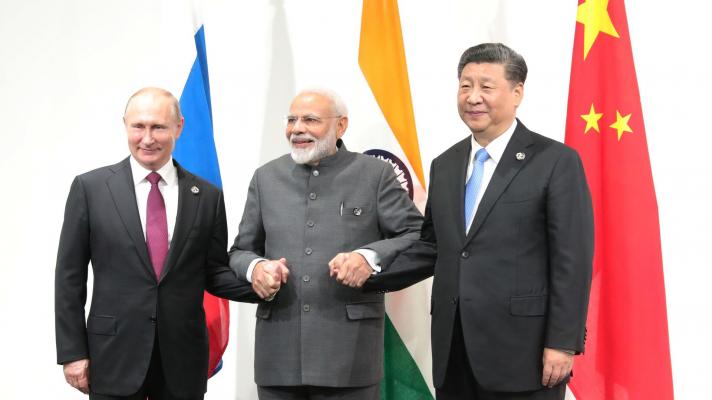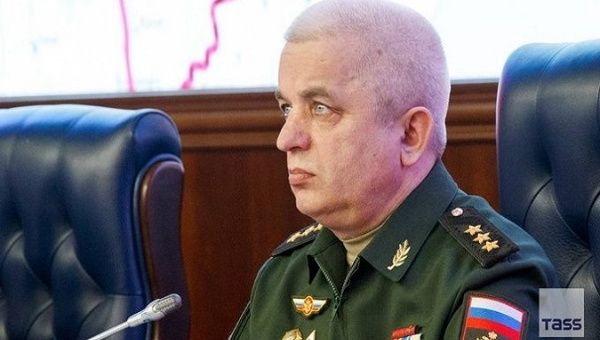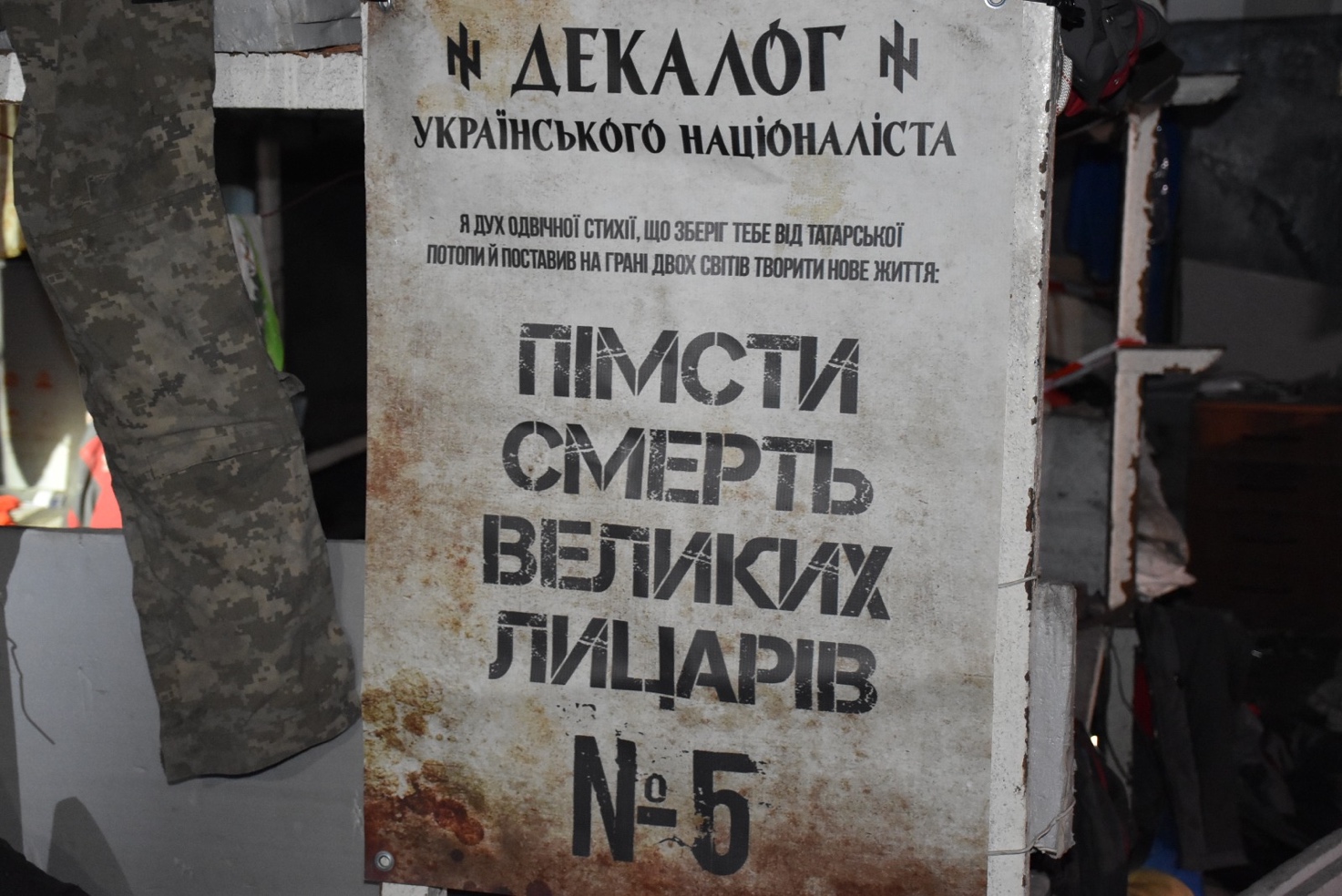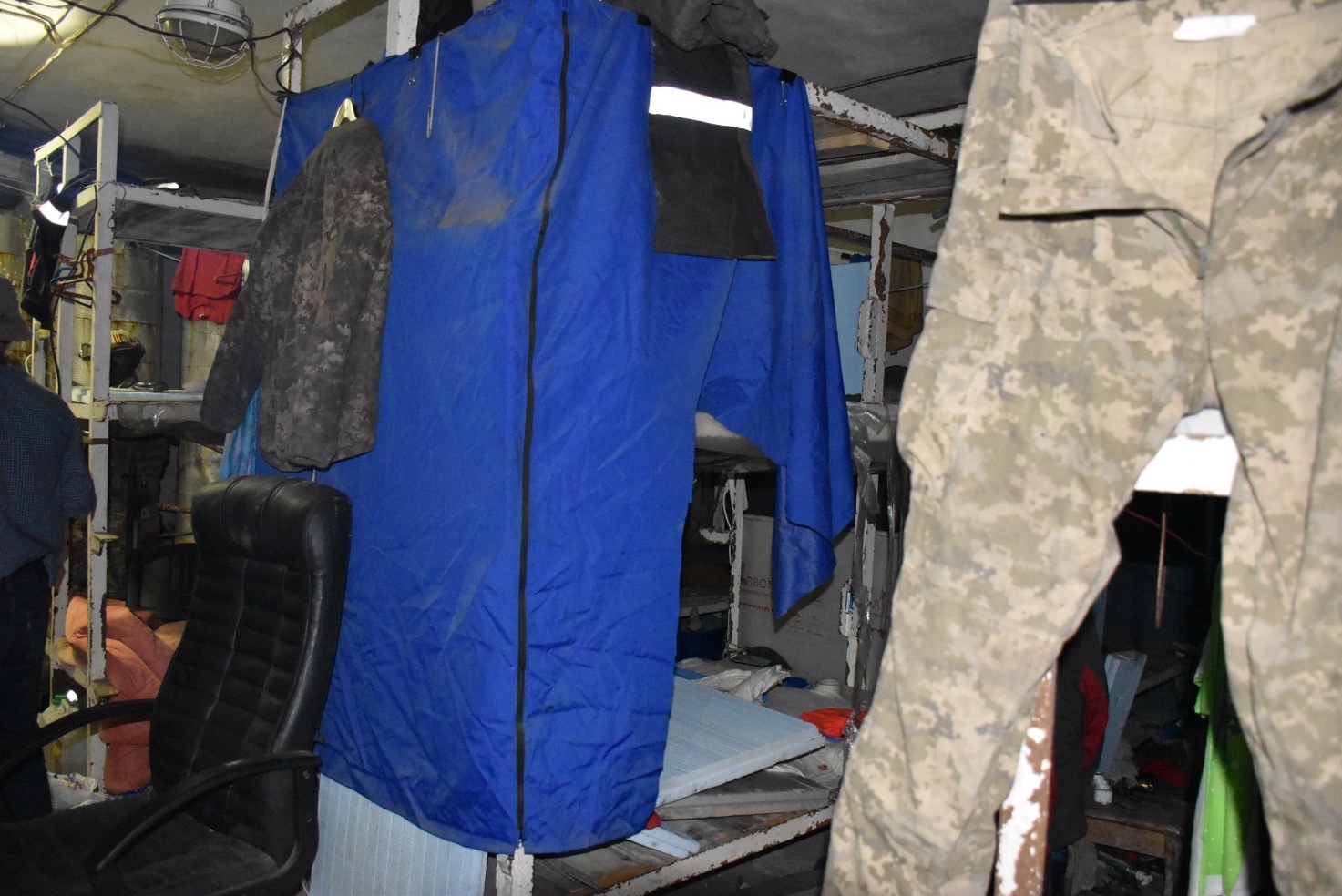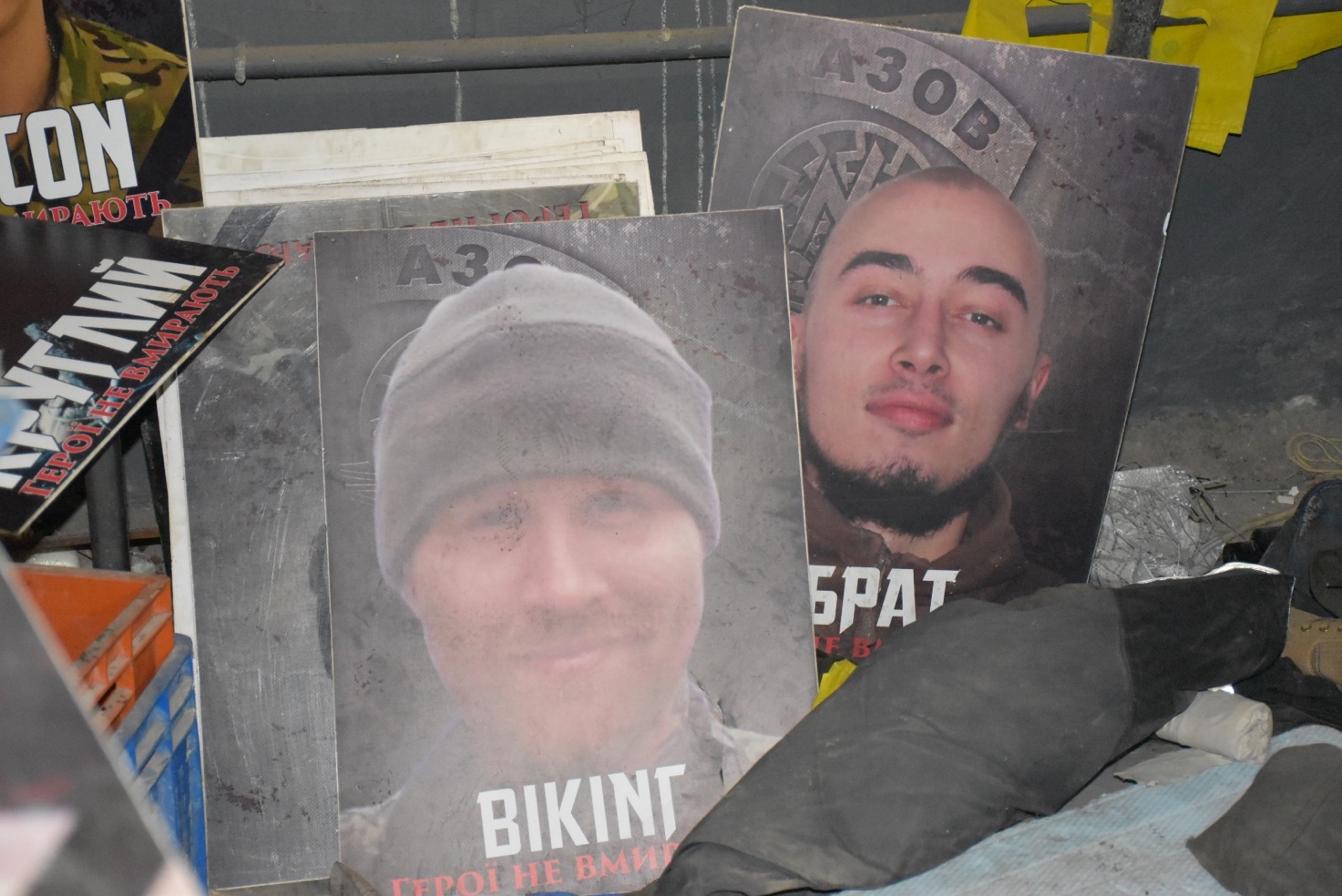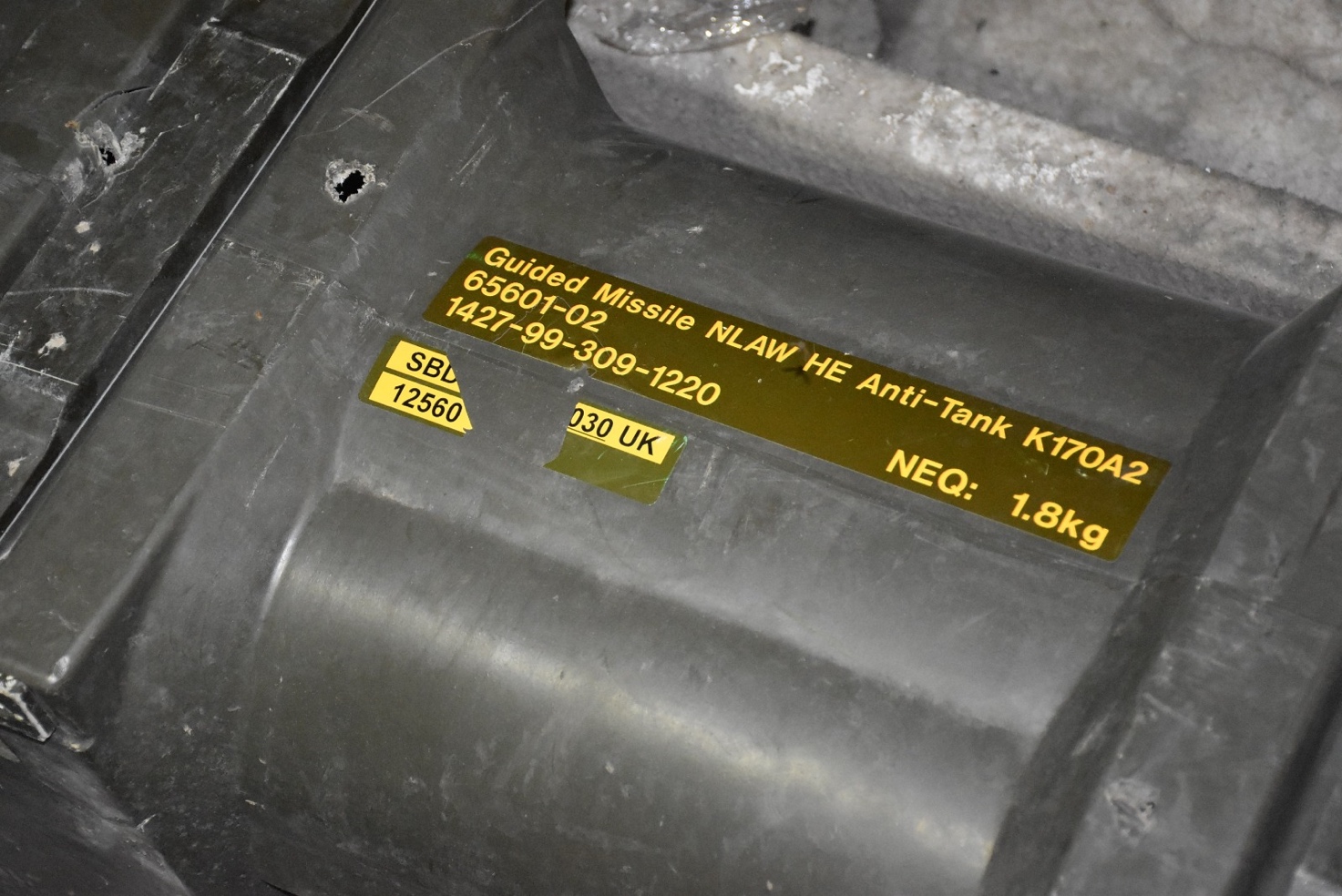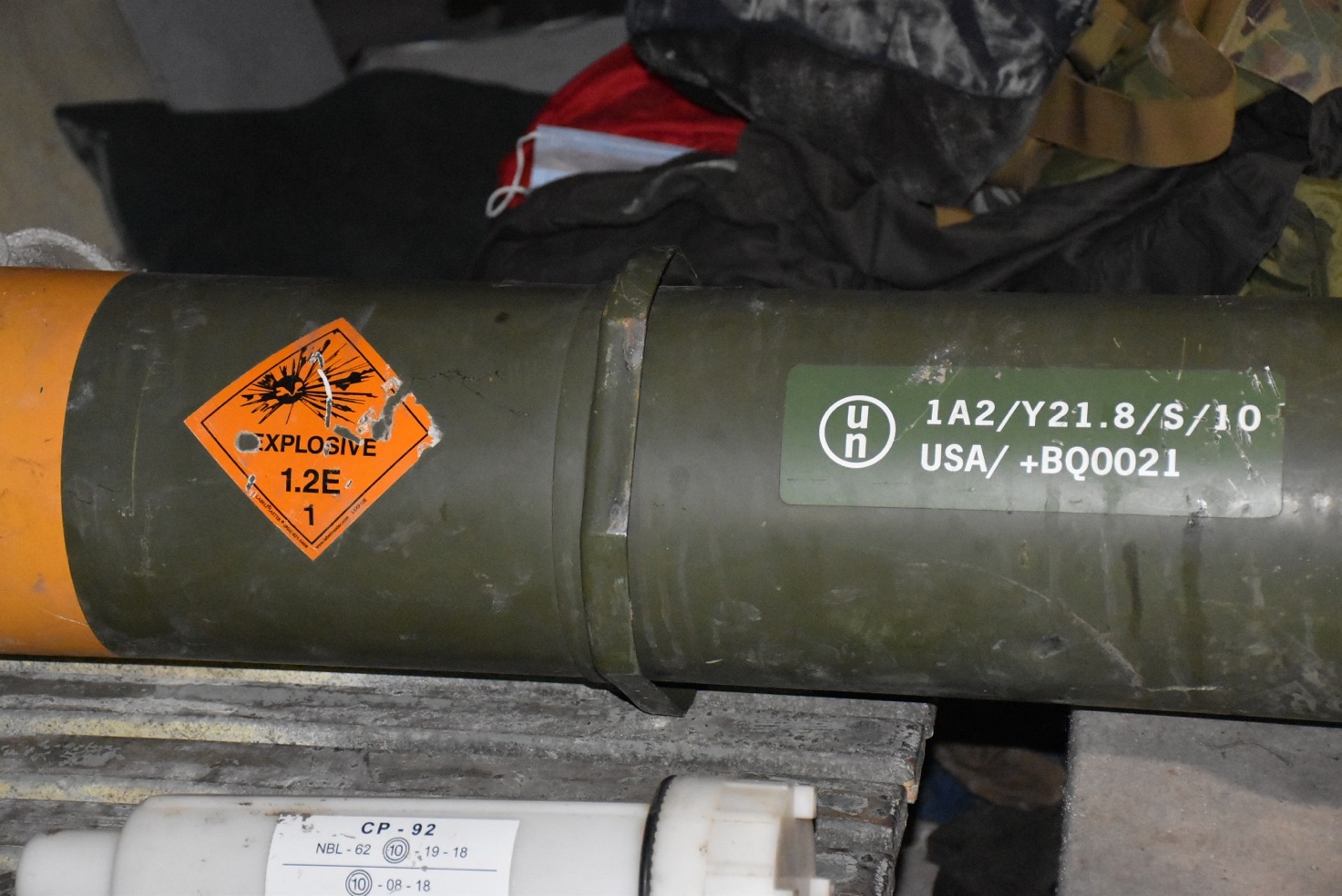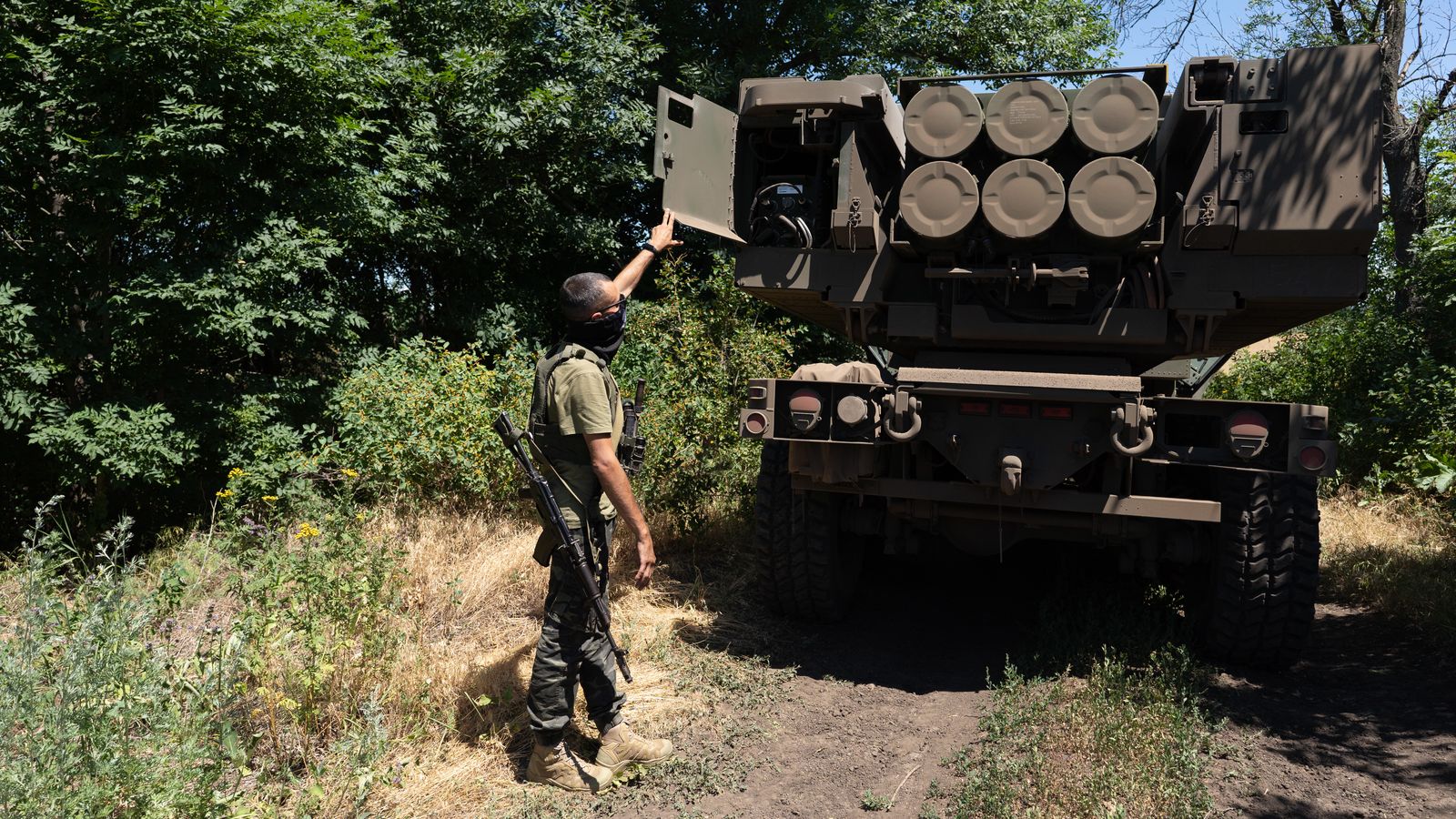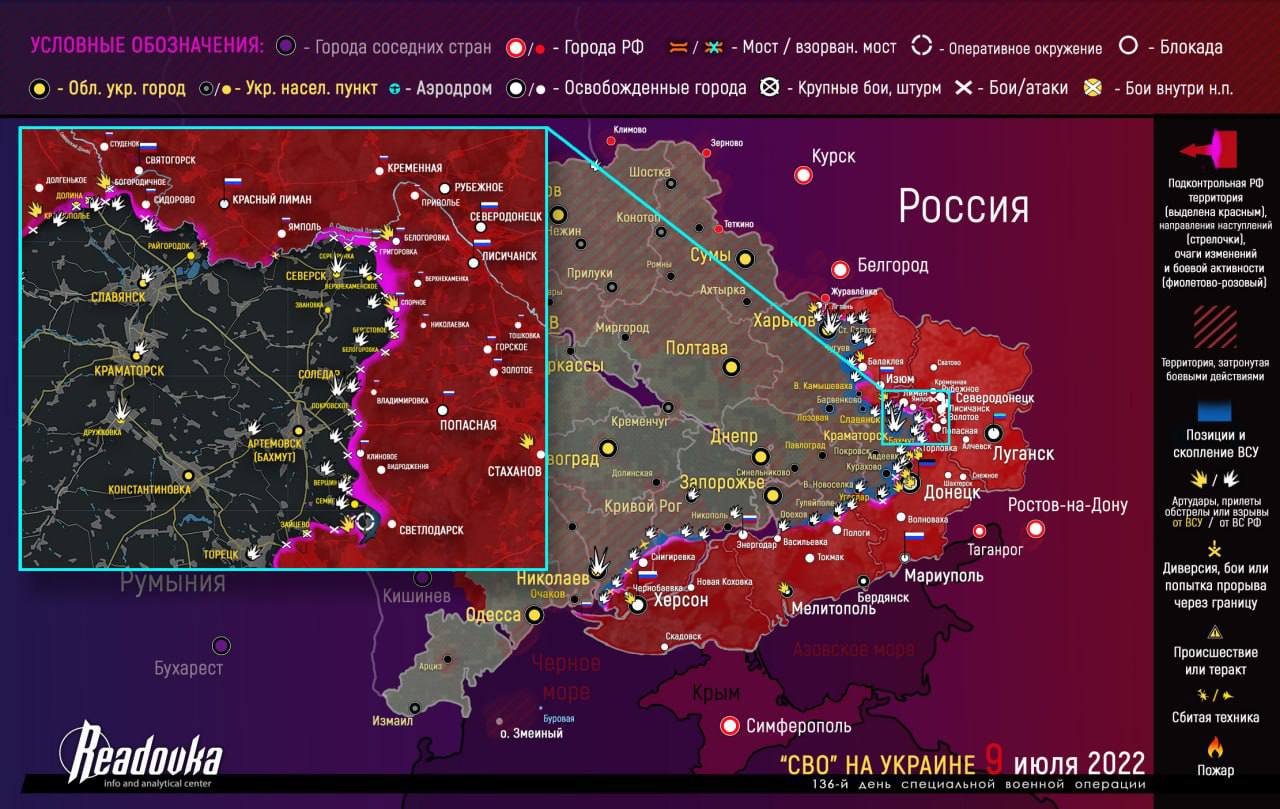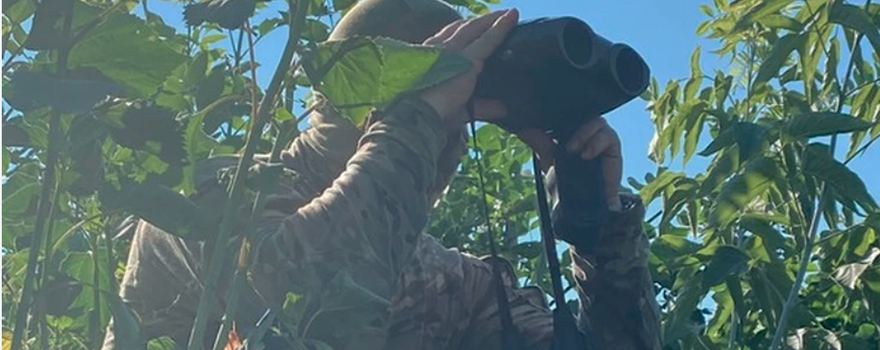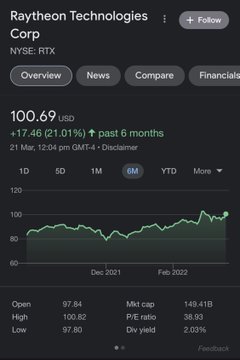in Lisichansk
POSTED BY @NSANZO ⋅ 07/08/2022
Original Article: Alexander Kots / Komsomolskaya Pravda
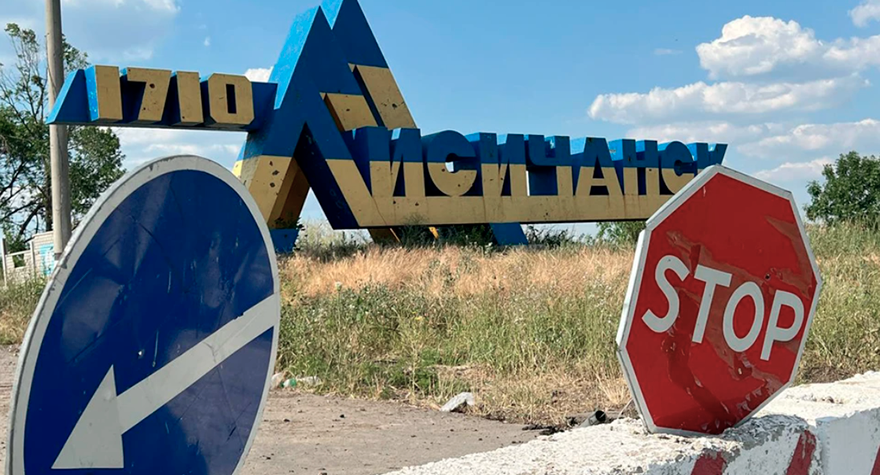
“So this is the result of the work of the Tulip ”, I thought, examining the state of the bridge connecting Severodonetsk with Lisichansk, destroyed to its foundations. A little over a month ago, I filmed in Rubezhnoe how the RPL army's 240mm self-propelled artillery was hitting somewhere in the direction of Lisichansk, cutting off the path of the retreat of the enemy garrison in Severodonetsk. In the heat, the river is shallow and some Ukrainian units were able to cross to the other side, albeit without equipment. They were also unable to resist the advancing troops at Lisichansk even though they had seriously prepared the defense. It turns out that they had been prepared for something else.
The news of the complete liberation of the Lugansk People's Republic caught me on my way to Lugansk from Belgorod. He was returning from vacation through the liberated territories, where the signal from the Republican telephone operator is already received without problems, the stores and administrative offices are open and there is even a traffic jam near the capital. A worker dressed in his bright green vest was directing traffic in a road repair zone: construction specialists from Russia ruthlessly remove the traces of eight years of war.
Trains with equipment moved along the tracks to the west. It is a great logistical help. The artillery advanced along the roads following the withdrawal of the troops from kyiv. It is the artillery that, in conditions of equal human resources, decides the outcome of the confrontation. But not only her. The Ukrainian Army was preparing to be attacked head-on.
This is shown by the fortifications that they had erected in the city. There is a whole network of trenches that turn into concrete shelters, at the entrance to Lisichansk. The city is on a hill and that is another advantage for the defenders. You can still find minefields, there are entire streets covered with these antipersonnel petals . And in the industrial zone there are bunkers, although inferior to the dungeons of Azovstal: an unambitious entrance to the basement in the wooded part near the factory, a chain of underground passages that breathe cold and penetrating humidity.
"Were it not for the local population, we would never have found this bunker," admits Leshin , commander of the RPL's Fourth Motorized Brigade. “We have only counted 120 beds. There are two other similar positions in a nearby hotel and in a workshop. There were also positions of the paratroopers of the Ukrainian Army in front of the plant. Lists of officers have been found in the destroyed base. As they fled, they threw away their helmets and vests. When we arrived, they were no longer there. They withdrew from the city, regrouped and tried to withdraw in columns. Not all of them made it. At the departure of a convoy of fifty vehicles, they lost up to twenty units and 300 troops. But that's just one column. There may be more."
"Where did they go?"
“To the Seversk district. They have entrenched themselves there, the city is well fortified, but that is not going to stop us”.
Through the dark corridors we emerged into a large underground barracks the size of about half a football field. All the space that can be seen with the light of our flashlights is littered with litters and the remains of food packages. The residents clearly didn't care about hygiene, the dumpsters are right next to the eating tables.
"Lisichansk was also well prepared for defense," I remember.
“They have had time for it. But our artillery practically did not work in the city, only targets where the enemy had been identified were attacked. It is unrealistic to pretend to identify places like this from the sky. This is where they hid."
"Why didn't they resist?"
“I think because of the experience of Severodonetsk and Mariupol. It was possible to dig in and defend for a month or two, but at what cost. How many casualties would they have had? After all, Mariupol and Severodonetsk have taught us a lot too. We have not gone forward. We have advanced in small groups and from different directions, securing the ground in the evenings, waiting for night and advancing again in the morning, identifying the enemy, striking with artillery and light weapons. They are afraid. His morale is at zero. A resident told me that at five in the morning a paratrooper from the Armed Forces of Ukraine took off the clothes of a 63-year-old woman and put them on, got on his bike and fled. If the paratroopers are like this, what can be said about the infantry?
It is true, but there is a detail that will surely be included in the story. It is no accident what is said: in war, the most important thing is the maneuvers. And the allied forces were able to maneuver in a way that kyiv did not expect. Within a short time, units of the Central Military District under the command of Colonel General Alexander Lapin were moved to Lisichansk undetected by enemy intelligence. They helped Luhansk troops to virtually besiege the city, expel the Ukrainian Army from nearby towns, and clear the green zone . Even so, the first entrance to Lisichansk was left to the Lugansk troops. It was something symbolic. So Leshin was one of the first to enter the city with his soldiers.
“How did the local population receive you?”
“Well, what if I say that the Ukrainians kidnapped women and released them two days later in a terrible state? We were greeted with a sincere welcome. We arrived at night. At dawn, we saw about 400 local residents in the market. They had gathered there in search of water or humanitarian aid. I sent out a reconnaissance team and it was immediately clear that we were welcome. They hugged us, kissed us and didn't let us leave the market for six hours."
We visited the city together with the battalion commander. I understand that the metaphor “not a single stone is left in its place in Lisichansk” is an embarrassing hyperbole exploited by Ukrainian propaganda. Yes, there is an area of tall buildings that has suffered serious damage in the battle. But there are areas like that in Donetsk, which have been bombed much harder for eight years. By the way, when in conversations with the civilian population and they are asked who fired the shot, they have no doubts. But regardless, Russia will rebuild everything, no matter where the shells were fired from.
We stop at a five-story building where the soldiers have brought modest humanitarian aid from their own pantry: cereals, flour, pasta. One of the women invites us to the basement to see how they have lived these months. The Ukrainian military forced them to hide there and they only came out with the arrival of Russian troops. The woman leads us down a dark, dank hallway with a flashlight that barely illuminates a small space in front of her.
“Here are the beds, we made them with doors. We cooked on the fire. We have been here for four months, we were waiting for you”.
"Did you get along with the Ukrainian defenders ?"
“Lately they had lost their form, they were drunk, they misbehaved. They bothered the girls, they wanted to take us by force to Ukrainian territory.”
"Weren't they from here?"
"No, from the west," the women say in unison. "Even speaking it was evident, they speak in the Western way."
There is no place where the division between east and west is more clearly manifest than here, in a half-dark basement. Those people who came from Ternopil and Lviv regions never considered these people as their own. And when the opportunity arose to impose their nationalist complexes on a defenseless population, they took advantage of it with such enthusiasm that local residents do not have to explain from whom they have been freed. On the street, the residents of a building do not let the volunteers leave: “We have been waiting for you for a long time. 129 days. We will pray for you."
"This part of the building faces an area where there were no Russian troops three days ago," explains a soldier standing next to a five-story building. “And the projectile fell to the east. In the background there is another projectile, also from that side. At some point, they bombed it.”
“This is our flat. A projectile hit on April 24 at half past three in the afternoon. It used to be a four-bedroom flat, now it's a one-bedroom flat,” a woman smiles sadly. The blast wave blew up the interior walls and the comfortable flat became, in a single instant, a mountain of cement mixed with memories that are now out of place in the form of family photo album remnants.
“It was Easter, we left the cellar in the afternoon, we made okroshka with the children, we ate here, and I took my brother to the shelter. Then he exploded. Well, we still have my parents' house. At least we have housing.”
I remember the strange passion of the Ukrainian Army for bloody provocations on religious holidays. The first blood of this war was spilled eight years ago at Easter, it was in Bilbasovka, near Slavyansk. Praviy Sektor militants attacked a picket line of local residents and killed three of them, who were armed with simple sticks. Now, the Ukrainian troops are withdrawing towards Slavyansk itself, building their defense line there in layers. The new front already crosses the Ukrainian-controlled part of the Donetsk People's Republic: from Seversk to Bakhmut. Arestovich, Zelensky's adviser known for his grand predictions, claimed that Lisichansk will be the last city the Russians will occupy. Sometimes it is better to keep silent.
https://slavyangrad.es/2022/07/08/24994/#more-24994
Google Translator
************************
War in Ukraine. Summary 07.07.2022
July 8, 11:18

War in Ukraine. Summary 07.07.2022
1. Lisichansk-Sverodonetsk.
The regrouping of troops to the Seversko-Soledarsk and Artemovsk directions continues. There is a combing of the area, not all the lagging groups of the Armed Forces of Ukraine have yet been caught. The cities themselves are still being shelled by the artillery of the Armed Forces of Ukraine.
2. Seversk.
Battles at Grigorovka and Verkhnekamensky. The Armed Forces of Ukraine have indicated their readiness to fight for Seversk and are not going to surrender the city without a fight.
At the same time, the RF Armed Forces are beginning to probe the chain of settlements between Seversk and Soledar for the possibility of bypassing Seversk from the south.
3. Artemovsk.
Fights in the Klinovoye area, as well as for Pokrovskoye.
The enemy is still holding Kodema and Semigorye.
4. Soledar.
Battles for Berestovoe and Belogorovka.
After the capture of the Disputable, one can expect a gradual "folding" of the front from the north towards Soledar.
5. Avdiivka.
No significant changes. Positional battles near the Avdeevka-Konstantinovka highway, there is no advance to Krasnohorivka.
Fighting on the outskirts of New York.
The enemy is intensively shelling Donetsk, Gorlovka, Yasinovataya, Makeyevka.
MLRS and OTRK strikes are underway at ammunition depots, fuel depots and locations of LDNR units deep in the territory of the DPR and LPR.
6. Carbon.
After an unsuccessful offensive attempt by the Armed Forces of Ukraine, the front in the area of Pavlovka, Shevchenko and Yegorovka stabilized, and the battles returned to the positional format.
In the area of Marinka and Novomikhailovka - no significant changes.
7. Slavyansk.
Battles at the Valley, Krasnopolye, Bogorodichny and Sidorov.
The front from the northwest is located 8-10 km from the outskirts of Slavyansk. The attacks of the RF Armed Forces on Slavyansk and Kramatorsk intensified.
8. Kharkov.
Positional battles to the north and north-west of the city in the area of the settlement. Udy, Tsupovka, Dementievka, Upper Passages, Upper Saltov.
There are regular strikes on targets in Kharkov, Chuguev and Zolochev. The enemy is waiting for the fresh units of the Russian Armed Forces to be brought into battle and their further advance to the northern outskirts of Kharkov. However, the assault on the city is not yet expected.
9. Nikolaev.
On the Nikolaev, Krivoy Rog and Nikopol directions - positional battles.
The Armed Forces of Ukraine are trying to gain a foothold in the area of the settlement. Potemkino and create the preconditions for further offensive actions.
The RF Armed Forces are actively striking targets in Nikolaev and in the Krivoy Rog region.
Despite all attempts, the AFU could not organize a significant attack on Kherson.
10. Odessa.
Against the backdrop of ongoing strikes on targets in the Odessa region, the Armed Forces of Ukraine held the expected photo shoot on about. Serpentine, received several blows on the landing and retreated. The island is still in the gray zone.
https://t.me/boris_rozhin/56524 - zinc
https://colonelcassad.livejournal.com/7725751.html
How to bypass your own sanctions
July 8, 9:45 am
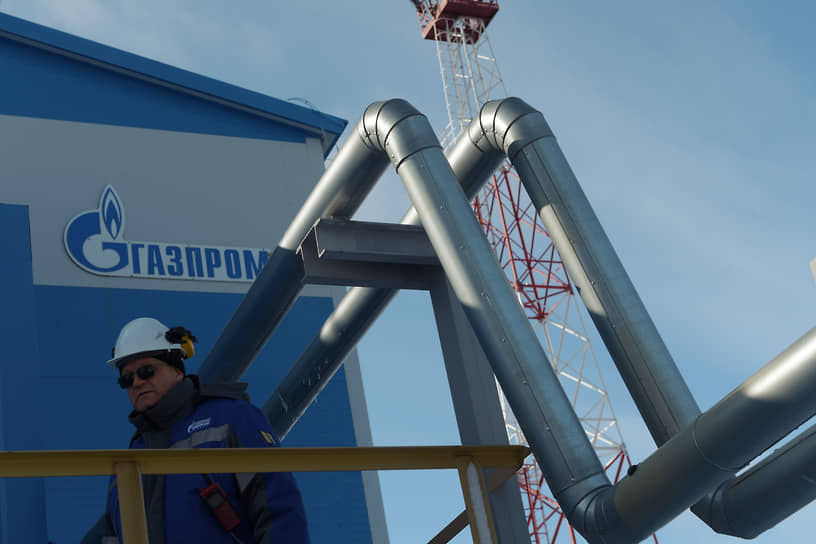
It is reported that Canada and Germany have almost reached a decision on how to circumvent the sanctions against Russia imposed by Canada and Germany.
Canada will return to Germany (or immediately to Russia) Siemens equipment (previously blocked in Canada due to sanctions), which is necessary for the operation of Nord Stream. Germany, in turn, will transfer the equipment to Russia as part of "technical procedures" and "exceptions from the sanctions regime." The threat of Gazprom to stop the work of Nord Stream for "maintenance" from July 11 makes the sanctions clowns hurry up. If you remember, at one time Germany quarreled about the supply of Siemens turbines to Russia. Now Germany itself is trying to find ways to circumvent sanctions and foist Siemens turbines on Russia, so long as it continues to supply gas. 3% of the world economy, they said...
Kyiv is already hysterical, as everyone understands that Gazprom has twisted Germany's arms and forced it to violate its own sanctions regime, which will be perceived as the most obvious victory of the Russian Federation in the economic war with the EU. But Germany does not have much choice, since the rejection of Russian gas in the current conditions means the collapse of some sectors of the German industry (the captains of which are trying to bring the inadequacies from the Scholz government to life), although even in the current conditions, Germany's competitiveness continues to decline, making it one of the main affected by the war in Ukraine.
It will be funny if, after the transfer of equipment to Russia, the "maintenance of the Nord Stream" will continue anyway.
https://colonelcassad.livejournal.com/7725061.html
Google Translator
******************
Peace negotiations between Russia, Ukraine to get more difficult with time: Putin
Xinhua | Updated: 2022-07-08 09:00
Russian President Vladimir Putin attends a meeting with State Duma leaders and party faction heads on July 7, 2022. [Kremlin photo]
MOSCOW, July 7 (Xinhua) -- Russia is open to peace talks, and the negotiations with Ukraine will get more difficult with time passing by, Russian President Vladimir Putin said Thursday.
"We do not refuse peace negotiations, but those who refuse should know that the more time they waste, the more difficult it will be for them to negotiate with us," Putin said during a meeting with State Duma leaders and party faction heads.
Putin said that the West led by the United States has been extremely aggressive towards Russia for decades.
"Our proposals to create a system of equal security in Europe were rejected. Initiatives for joint work on the problem of missile defense were rejected. Warnings about the unacceptability of NATO expansion are ignored," he added.
The attempts of Western countries to impose a new order on the world are doomed to fail, said the president.
https://www.chinadaily.com.cn/a/202207/ ... 6b3bb.html
***********************
Russia: Lithuanian Corridor Could Cancel Retaliatory Measures
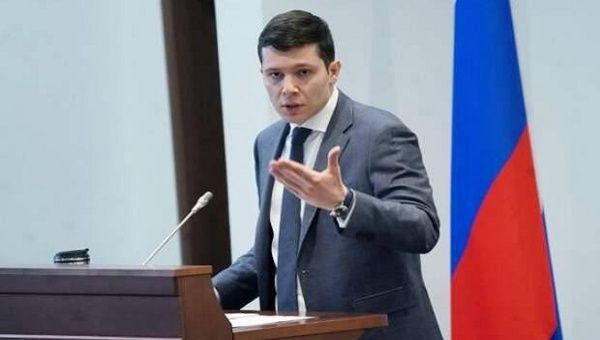
Russian Governor to Kaliningrad suggested the creation of a green corridor through Lithuania. Jul. 7, 2022. | Photo: Twitter/@UcraniaOtro
Published 7 July 2022 (9 hours 29 minutes ago)
On Thursday, the Russian governor of the Kaliningrad Region said that the creation of a corridor via Lithuania could cancel Russia’s tit-for-tat measures.
The Russian Governor for the region of Kaliningrad, Anton Alikhanov said Thursday that a ‘green corridor’ via Lithuania, would be conditional in the process of negotiation, in light of the prohibition of transit through the Kaliningrad Region.
"This s one of negotiating positions we should maintain. You understand, if they do not return transit now, we will take tit-for-tat measures," said the Governor of Kaliningrad.
"Lifting of such restrictions can be linked with the creation of the corridor," he added.
The Governor suggested negotiating the creation of a corridor in Lithuania, where it will be possible to access the region without invading Lithuanian territory.
Kaliningrad proposes to ban the transit of Russian goods via the Baltic countries: The Kaliningrad region proposes to ban Russian exports and imports via the Baltic countries. This was announced by Governor Anton Alikhanov.
He highlighted the fact that similar examples have been in history.
https://www.telesurenglish.net/news/Rus ... -0027.html
****************
Russia Steals the Thunder in ‘Wheat War’
JULY 7, 2022

Russian Defense Ministry in Frunzenskaya Embankment, Moscow. File photo.
By M. K. Bhadrakumar – Jun 30, 2022
In a master stroke of military diplomacy, Russian Foreign Ministry announced today that it is “withdrawing” the garrison in Snake Island, the hotly contested Black Sea property from where Ukrainian forces were evicted in March in the early days of Moscow’s special military operation.
This decision comes a day after Foreign Minister Sergey Lavrov and UN Secretary General Antonio Guterres discussed food security amid the situation in Ukraine, in a phone call Wednesday. The Russian readout said Lavrov “underscored that the export of Ukrainian grain is being prevented by Kiev’s mining of the Black Sea.”
Furthermore, Lavrov “reaffirmed readiness to continue fulfilling its obligations on export of food and fertilisers, despite their fulfilment being significantly complicated by the illegal unilateral sanctions of Western states and disruption of global production and retail chains due to the COVID pandemic.”
Importantly, Lavrov conveyed to Guterres Moscow’s “intent for further work on reduction of threats of the food crisis, including in cooperation with the UN.”
The Russian Defence Ministry while announcing the withdrawal from Snake Island, called it a “goodwill gesture” and linked it to the crisis of food security. It added, “The Russian Federation has demonstrated to the international society the absence of any obstacles for the efforts of UN to establish a humanitarian corridor for transporting agricultural products from Ukraine.
“This solution will prevent Kiev from speculating on an impending grocery crisis citing the inability to export grain due to total control of the northwestern part of the Black Sea by Russia.
Now it is up to the Ukrainian side that is still not clearing the Black Sea coastline, including the harbour waters.”
In effect, Russia has challenged Kiev to do its part by removing the mines in the approaches to its ports. But this act of diplomacy is not without serious military implications. Kiev will surely celebrate this as a “military victory”.
However, on the face of it, Moscow is taking a gambit — a clever action that takes the wind out of the sails of Western propaganda blaming Russia for the food shortage as if this situation is the result of its 4-month old operation in February rather than a crisis that had been snowballing through the past four or five years for which the US and the Western countries are to be blamed.
But, as with any gambit, this ploy involves taking a risk insofar as the Russian retreat from Snake Island could be seized by Kiev to retake that strategic piece of real estate in the Black Sea, something that its American and British military advisors have been pressing for. Moscow has taken precautions by stating that it won’t accept wheat cargo ships being accompanied by western warships or drones and that it reserves the right to inspect the ships and ensure they are not carrying military stuff.
So far, two major operations by Kiev with the indirect participation of the Americans and British advisors to seize Snake Island by force were beaten back by the Russian forces. The Western military analysts estimate that the Russian presence on Snake Island would pose threat to NATO’s assets in next-door Romania. (See my blog Southern Ukraine is the priority in NATO’s planing, Indian Punchline, June 22, 2022.)
However, this Russian move also has a certain political resonance insofar as it can be construed as going beyond issues concerning Ukraine’s wheat export. Of course, the facilitation of “humanitarian corridors” in the Black Sea obviates the need for any Western intervention, as implied in the G7 Statement on Global Food Security issued in Elmau, Germany on 28th June backing “UN efforts to unlock a safe maritime corridor through the Black Sea.” This is the first thing.
Indeed, Russia, which accounts for accounted for 16% of global wheat exports, and Ukraine, which accounted for 10%, are not the only key global exporters of wheat — for instance, the US and Canada, which export 26 and 25 million tons of wheat, respectively (or around 25% of global exports) and other major western producers France (19 million tons) and Germany (9.2 million tons) accounting for another 12% of global exports are unwilling to share their grain with those in need, prioritising their own food security in the recent years.
Of course, these rich western countries have their own difficulties related to energy prices, production costs and inflation. They would want to keep their raw materials to shield their economies from further inflation spikes. Simply put, in the event of currency instability, or indeed any form of economic or political instability, it is always more prudent to have raw materials than cash: it does not depreciate as quickly as currency.
The problem with the supply of such a widely produced commodity as wheat will most likely be solved only if the US and EU allow Russia, the largest exporter of wheat in the world, to share supplies in exchange for the removal of sanctions. The western sanctions have forced international companies to sever long-standing business ties and leave Russia, which caused supply disruptions. In one example, the EU last month banned cooperation with the Black Sea port of Novorossiysk, through which more than half of the exported grain from Russia is shipped.
What worries the West most is that Africa’s heavy dependence on Russian wheat supplies have a strategic dimension that boosts Moscow’s influence in that continent. The rapidly growing Russian presence in Africa challenges the western neo-colonial projects of European countries. This is already evident in the Sahel region.
At any rate, Russia still retains its dominance over the Black Sea and can not tolerate any threat to Crimea. The goodwill gesture on Snake Island apart, there is no let-up in the Russian special military operation in southern Ukraine, either.
In this context, President Putin’s remarks at Ashgabat yesterday are to the point when he was asked by the media about the “current goal” of the Russian operations. Putin said:
“Nothing has changed, of course. I talked about it in the early morning on February 24. I talked about it directly and publicly for the entire country and the world to hear. I have nothing to add. Nothing has changed… I trust professionals. They are doing what they consider necessary to attain the overall goal. I have formulated the overall goal, which is to liberate Donbass, protect its people and create conditions that will guarantee the security of Russia itself. That is all. We are working calmly and steadily. As you can see, our forces are moving forward and attaining the objectives that have been set for the particular period of the engagement. We are proceeding according to plan. [Emphasis added.]
“We are not speaking about any deadlines. I never speak about them, because this is life, this is reality. It would be wrong to make things fit any framework, because, as I have already said, the issue concerns combat intensity, which is directly connected with possible losses. And we must think above all about saving our guys’ lives.”
Here, the operative words are: “create conditions that will guarantee the security of Russia itself.” After all, Snake Island is only some 175 miles from Sevastopol, the Russian naval base in Crimea.
(Indian Punchline)
https://orinocotribune.com/russia-steal ... wheat-war/
****************
Zelensky says Ukraine will not give up territory for peace with Russia: ‘This is our land’
By Jeremy Herb, CNN
Updated 7:06 PM EDT, Thu July 7, 2022
Ukrainian President Volodymyr Zelensky told CNN’s Wolf Blitzer on Thursday that Ukraine is unwilling to cede any of its land to Russia, standing firm that a concession of Ukrainian territory won’t be part of any diplomatic negotiations to end the war.
“Ukrainians are not ready to give away their land, to accept that these territories belong to Russia. This is our land,” Zelensky said in an exclusive interview aired Thursday on CNN’s “The Situation Room.”
“We always talk about that, and we are intending to prove it,” he added.
Zelensky spoke to CNN at the same time as one of his top Western allies, British Prime Minister Boris Johnson, announced he would be resigning. Speaking in Ukrainian via a translator, Zelensky said he was confident that Britain’s policy toward Ukraine “will not be changing” even if the country’s leadership is in tumult.
“He resigned not because he was in Ukraine. I think on the contrary, what Johnson has been doing for Ukraine was helping us a great deal. I consider him a friend of Ukraine, but I think his society also supported Ukraine in Europe. That’s why I think the UK, it’s on the side of good, on the side of Ukraine,” Zelensky said.
“And I’m sure the UK policy toward Ukraine is not … changing because of Boris Johnson’s resignation. Our relations obviously gained a lot from Boris Johnson’s understanding of things. We went through a lot of dramatic moments quite quickly. The help we needed was delivered rather quickly … if (his resignation) will affect this speed of help I don’t know. I will pray to God it won’t be affecting that help.”
Russia’s war with Ukraine has now lasted for more than four months, with no sign of either side backing down soon. Ukraine’s early successes forced Russia to scale back its initial aims of toppling Kyiv, and Moscow’s forces have now focused on taking territory in eastern Ukraine. Russian forces have now occupied most of the Luhansk region, outside of a few pockets of resistance, and are pressing toward cities in Donetsk.
CNN reported last week that White House officials are losing confidence Ukraine will ever be able to take back all of the land it has lost to Russia since the war began, even with the aid of heavier and more sophisticated weaponry that the US and its allies plan to provide Kyiv.
(more...)
https://us.cnn.com/2022/07/07/politics/ ... index.html
This guy makes 'Baghdad Bob' look like a pessimist...
**************************
Life in a Time of Conflict in the Russia-Ukraine Frontier City of Belgorod
Posted by INTERNATIONALIST 360° on JULY 7, 2022
 Employees of the Russian Emergency Situations Ministry are seen near the damaged residential buildings in the border town of Belgorod, Russia. © Sputnik / Taisia Liskovets
Employees of the Russian Emergency Situations Ministry are seen near the damaged residential buildings in the border town of Belgorod, Russia. © Sputnik / Taisia Liskovets
Mark Bratchikov-Pogrebisskiy reports from а region where an accident of geography has again placed it centre stage.
Belgorod is one of seven Russian regions that border Ukraine. In 2014, it gave refuge to people fleeing from Kharkov, Donetsk, and Lugansk, and in 2022, it did the same all over again.
Recently both the city of Belgorod and nearby towns and villages, on the border, have been the target of regular airstrikes. People were evacuated from several settlements, and access to them has been restricted.
In the early hours of July 3, four people in Belgorod were killed by an unguided Tochka-U tactical ballistic missile almost certainly fired by Kiev’s forces. In a tragic irony, three of the victims were Ukrainians, who had sought refuge in the area to escape the fighting across the frontier.
Belgorod’s history has been defined by its status of a border outpost since its foundation in the late 16th century. A surviving record says that in 1596, Tsar Fyodor I, the son of Ivan the Terrible and the last ruler of the Rurik dynasty, ordered “to have the city of Belgorod built on the Seversky Donets, and the city of Oskol built on the Oskol river.” Since February 2022, the Seversky Donets has made more headlines than any other river. The city of Stary Oskol remains one of the key cultural and religious centers in the area.
In 1719, Peter the Great had Belgorod upgraded in status. It became the capital city of the eponymous province within the Kievan Governorate of the Russian Empire. Sixty years later, Belgorod and the surrounding territories were split between the Kursk and Voronezh Regions. The end of the 18th century saw Catherine the Great take control of Crimea, thus expanding the empire’s territory. Belgorod at the time lost its status of a border fortress.

A list of names of WWII soldiers buried in Shebekino © RT
By the early 20th century, Belgorod had evolved into a major railway hub connecting Sumy and Volchansk (both Ukrainian cities today). In 1918 and 1919, it was occupied by German troops and became part of the Ukrainian State established and ruled by Hetman Pavlo Skoropadsky who collaborated with Germany and Austria. Later, during WWII, Belgorod was occupied by Nazi Germany twice. The city’s liberation on August 5, 1943, was celebrated with fireworks in Moscow. According to the Russian Statistics Agency, the population of Belgorod Region in 2022 totals about 1.5 million people.
This and other facts are part of the program offered by the museum of local lore. On June 13, 2022, some refugees from Ukraine left these comments in the museum’s guest book: “We are now in this beautiful city because of the special military operation. The museum is so inspiring, like a breath of fresh air we haven’t had in a long while.”
Air flights to and from Belgorod were cancelled on February 24. The same day, reports came in about the first victims of an air attack. A few days later, another assault followed: multiple calls were made reporting fake bomb threats at public buildings.
On March 23, a border village was shelled, leaving three civilians injured. The villages of Zhuravlyovka and Nekhoteyevka were put on high alert. The authorities strongly advised residents to flee. However, about 46 people were still living there as of mid-May 2022 despite the risks, according to Belgorod Region Governor Vyacheslav Gladkov. The shelling of the two villages continued; the number of damaged houses and wounded residents (mostly elderly) grew. Locals reported at least one incident when they had to spend the night hiding in a basement. On May 11, 2022, Ukrainian shelling took the life of 18-year-old Ruslan Nefedov, from the village of Solokhi.
A veteran reporter from Belgorod, who is native to the region, talked to RT about what he saw after the shelling. He said that the residents who refused to leave their homes cited a belief that warnings first seemed disproportionate to the threat they faced. One person cited a reluctance to part with the handcrafted agricultural tools they owned.
The locals appeared to be equally relaxed about the fire at the oil depot in Belgorod that occurred on April 1. According to Russian officials, it was caused by an attack from a Ukrainian helicopter gunship. The thick black smoke was visible from all parts of the city. People living close to the area were evacuated to other neighborhoods.
There were reports of serious traffic congestion close to the burning depot – due to the high number of people wishing to drive closer and capture the incident on video, the reporter told RT. A printing house in Belgorod was also hit in early April. The mother of one resident who talked to us is an employee there and had a lucky escape on the day of the shelling, since she was working from home at the time.
According to the Russian Defense Ministry, Ukraine fired three unguided Tochka-U missiles with cluster warheads at a residential neighborhood in Belgorod in the early hours of July 3. The city of Kursk also came under fire. Tu-143 Reis drones rigged with explosives were used in that attack. The city’s missile defense systems intercepted all the rockets, yet one damaged rocket crashed into a residential building in Belgorod. The governor reported four people killed and four injured, including a child. As mentioned above, three of the deceased were Ukrainian citizens – locals said they were a family from Kharkov waiting for the hostilities to end. Over 60 private houses and apartment buildings were damaged. The Defense Ministry emphasized that there were no military targets close to the damaged area and that “the missile attack was planned and carried out to harm the civilian population of the Russian cities.”
In early March, Russia opened humanitarian corridors to Belgorod for Ukrainians willing to leave Sumy and Kharkov located about 80km away. Prior to the beginning of Russia’s military operation in Ukraine, Belgorod had been accepting refugees from Lugansk and Donetsk for some time, due to increased tensions there, much in the same way as back in 2014.
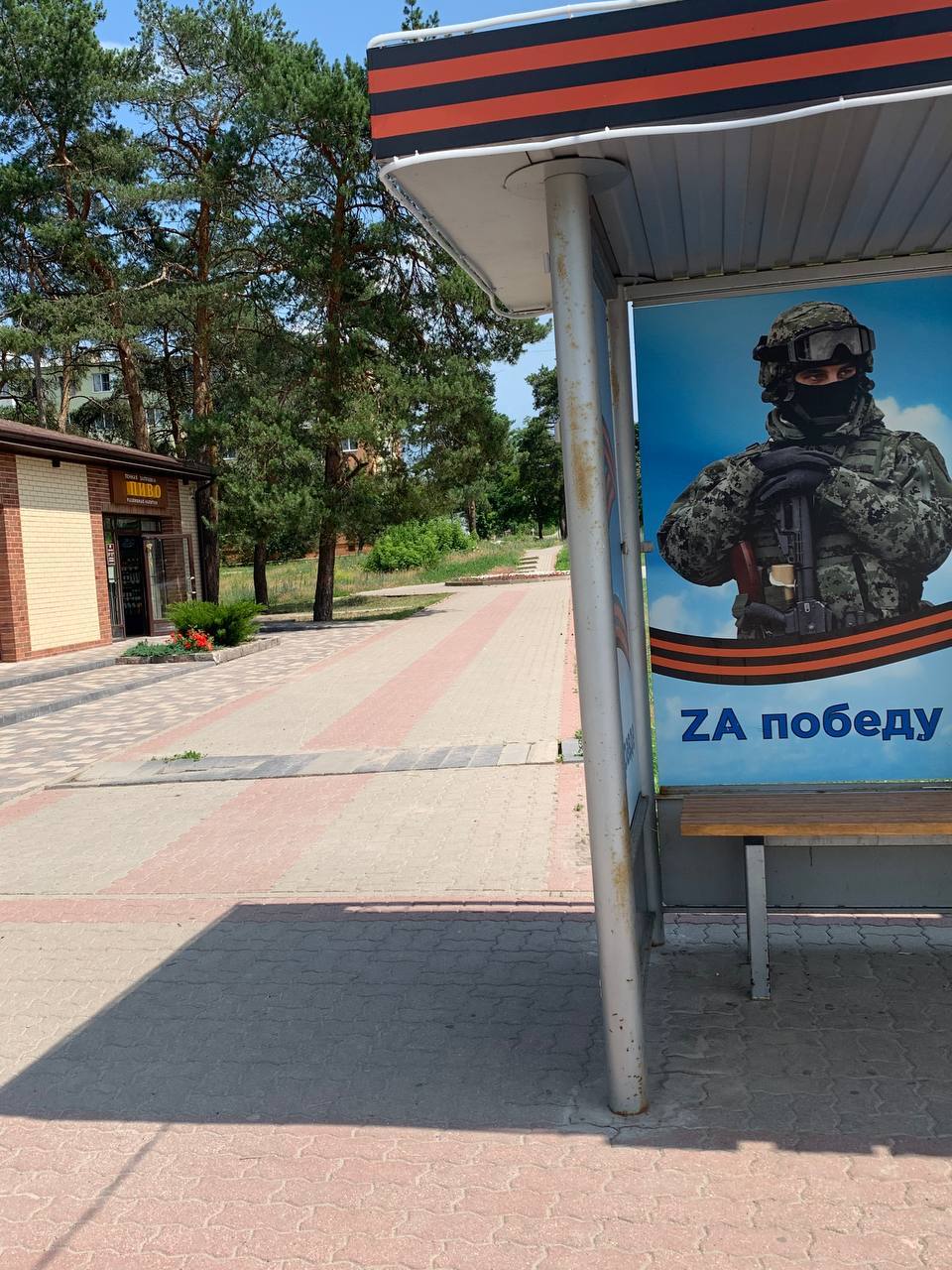
'For the Victory’ banner in Shebekino © RT
Residents of Belgorod told RT that many Russian-speaking people from Kharkov and places around it arrived. One couple said they were stopped by armed Ukrainian police who would only speak Ukrainian. They replied to them in Russian, which prompted a demand to speak Ukrainian. When they obeyed, however, the officers beat them up for faulty pronunciation while bystanders stood and watched. The couple decided to leave the country and now they say they aren’t sure they’d want to return to Kharkov in the future.
Many Belgorod residents have extended family in and around Kharkov, and there are several Ukrainian-speaking settlements there. The Belgorod Region as an administrative entity was established in 1954 by Soviet authorities who at the time weren’t particularly mindful of linguistic or nationality aspects. Until the 2014 Western-backed Maidan, Belgorod residents were in the habit of visiting Kharkov on holiday and for better shopping opportunities.
Yet somehow it happened that Kharkov has become an unsafe place for ethnic Russians in post-Soviet Ukraine. On the one hand, Kharkov was a lot less radical than Lviv or Ivano-Frankovsk, yet on the other hand, the overall mood there was very different from that in Lugansk or Donetsk, where people supported Russia. Kharkov, where contact between all things Russian and Ukrainian became so intense, evolved into a breeding ground for some radical groups. Andrey Biletsky, the former leader of the infamous Azov Battalion (banned in Russia) was born there. In mid-April 2022, when the governor of Belgorod Region visited a refugee center, it sheltered a total of 107 Ukrainians: 58 from Izyum and 49 from Kharkov.
Founded by Tsar Alexis of Russia in the 17th century, Kharkov was the capital of the Ukrainian Soviet Socialist Republic for a brief period of time, until 1934. The Kharkov Polytechnic Institute was established in 1885 with help of chemist Dmitry Mendeleev. The institute supplied a qualified work force for the Shebekino Chemical Plant, which was established after World War II and manufactured household chemicals and laundry detergents for the entire Soviet Union.
Today, Shebekino is only seven kilometers from the border with Ukraine. The town’s population is estimated at 40,000 people. An elderly man, who has worked as a driver at the chemical plant his entire life, described to RT the dynamics between Shebekino and Volchansk. Just 15 kilometers separates one town from the other. Since February 24, Volchansk has been under Russian control.
“The Volchansk Meat Processing Plant was established before the Revolution. Many Shebekino residents used to take the train to Volchansk, but local shopkeepers weren’t always happy about it. Some even refused to sell their merchandise to anybody from Shebekino. Others went as far as closing their doors. ‘Look, the Chinese are here again,’ they used to say in Volchansk about their neighbors from Shebekino [a reference to a stereotype about Chinese tourists buying everything they can on trips abroad – RT]. Now that the border is open, the tables have turned and people from ravaged Volchansk take trips to Shebekino to shop for groceries and soap.”
When asked about the situation in Shebekino, the man shrugs: “It’s always boom, boom from the other side, time and again. I’ve had quite enough of this.”
Yuri Trofimov, editor-in-chief of the Shebekino newspaper Krasnoye Znamya, told RT: “We even have several Ukrainian-speaking villages, and a lot of people with Ukrainian surnames. We have strong family ties with Kharkov, which is also full of Russian speakers. Of course, everyone wants this to end as soon as possible.”
Reporting on the assistance provided to Kharkov refugees, the region’s governor said in early July that “25 tons of transformer oil have been delivered to restore power supply in the Kupyansk, Izyum, and Balakleya districts of Kharkov Region… Balakleya was especially struggling, since the substation that powered the entire town had been destroyed almost a month ago. Thanks to our joint efforts, more than 20,000 people got power in their homes, and, most importantly, the critical infrastructure is now operational.
“When I came here 18 months ago, I heard people say that Belgorod had always been Kharkov’s backyard. It made me wince every time. I felt like it should be the other way around,” Gladkov said in early June.
People in Belgorod, who are not so much frightened as tired, have also had to put up with attacks on their peace of mind through fake news. For example, at one point, the Ukrainian Armed Forces were reported to have “occupied” Elementary School No. 2 in Sereda, a border town in Belgorod Region. It turned out, however, that there was no elementary school of that number there, only a kindergarten. Another fake report claimed that tap water in Belgorod Region was infected with cholera.
School children in Shebekino initially spent a short time learning remotely, and then continued to study full-time in class. All the students had to take the final Unified State Exam in one school “that was the farthest from the Ukrainian border, while the truth was that it was perhaps a hundred meters farther than the other one,” locals told RT.
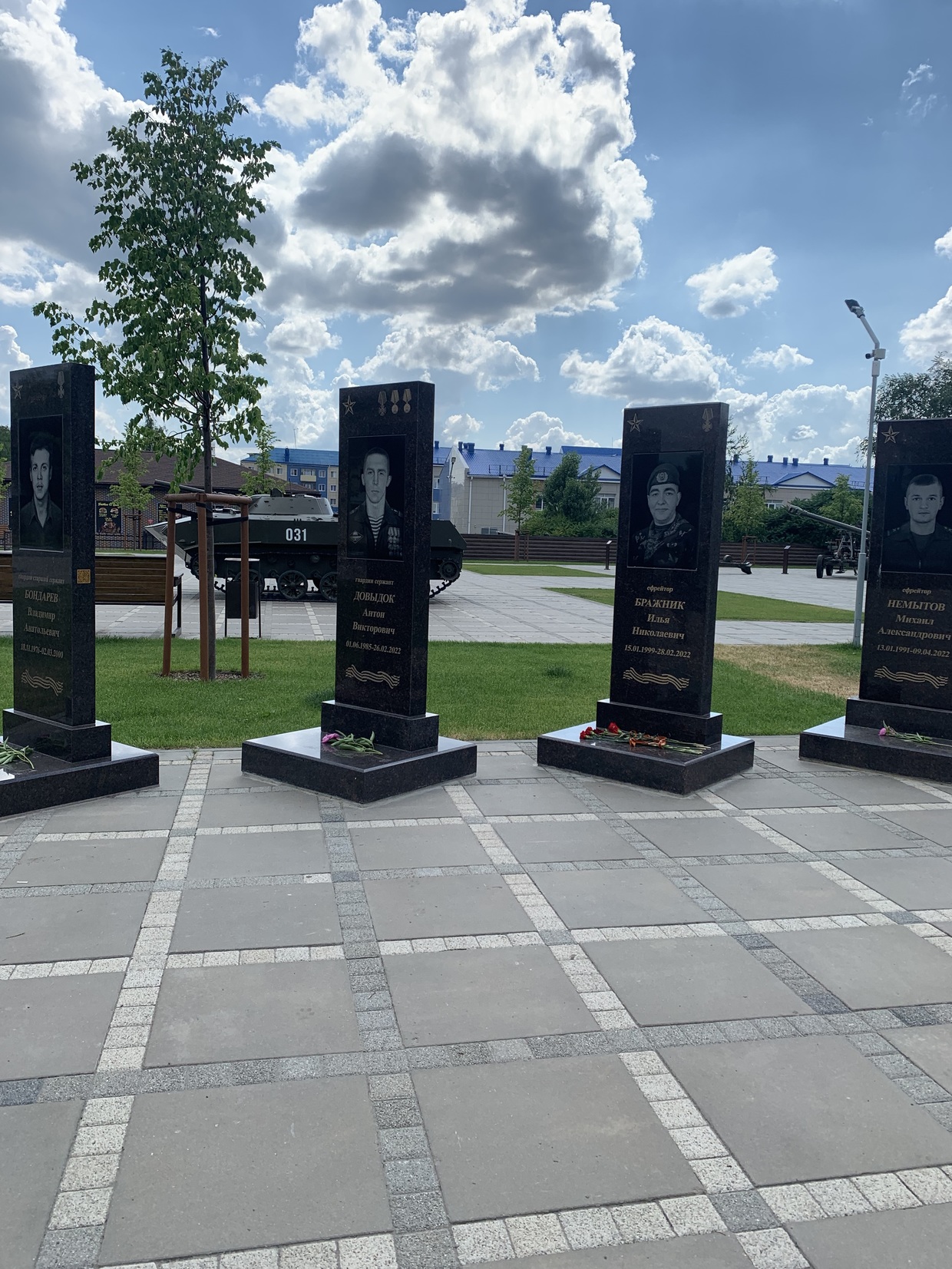 “We hear explosions every night. Everyone is used to it by now,” Alina, a student from Belgorod Pedagogical College says. “The college management said that we’ll stop studying full-time only if the building gets hit. But even then, there’s a greenhouse, and if the college is bombed, classes may continue there,” she added.
“We hear explosions every night. Everyone is used to it by now,” Alina, a student from Belgorod Pedagogical College says. “The college management said that we’ll stop studying full-time only if the building gets hit. But even then, there’s a greenhouse, and if the college is bombed, classes may continue there,” she added.
A military field hospital was once again set up in Shebekino, almost 80 years since WWII, when one functioned here in the summer of 1943. There is a small cemetery in the town for the soldiers who “died of their wounds” in the 1940s. These days, the town has three more memorial plaques honoring those who died “in the line of duty” during the 2022 military offensive. They were installed reverently in one of the town squares and are dedicated to Sergeant Dovydok (born in 1985), Corporal Brazhnik (born in 1999) and Corporal Nemytov (born in 1991).
The local park is full of soldiers. Some say they are from the Amur Region in the Far East. Saleswomen, who sell mineral water to the soldiers, tell us that they have also become used to the whole thing:
“The explosions used to start every night at midnight or a little after. Sometimes, shelling occurred during the day. Yet by mid-June, it got quieter. Before that, planes were circling over the town, flying really low. However, none of that stopped the urban improvement project that had been under way in the town and the surrounding area since February. Some people left when hostilities began. Some went to Belgorod, others went as far as Krasnodar {in the south of Russia}. But there is no point. If it gets you, it will get you anywhere.”
A taxi driver, a veteran of the Second Chechen Campaign who RT was able to talk to on the way from Shebekino to Belgorod, is convinced that the Ukrainian side had been preparing for the conflict for a long time. This view is shared by local journalists and people living near the border. One of them, Nikita Prokopchuk, tells a story that is impossible to corroborate: in early winter, long before February 24, Ukrainian troops that had amassed near the border and were allegedly testing Western-made equipment during the night, including some NATO Unmanned Aerial Vehicles (UVA). One of the drones unexpectedly changed its trajectory and crashed. The search in the snow continued for several hours. The soldiers were swearing in perfect Russian.
Long before that, in the fall of 2021, local journalists reported activity on the Ukrainian side of the border, where soldiers provoked Russian border guards, shouted insults from afar, and even ran naked along the border.
Andrey Zhdanov, a Belgorod writer who spoke to RT said:
“To be honest, it surprised me that people in Belgorod were so prepared for all this. Maybe it’s because we live near the border. It’s a fact that people in local villages are very peace loving. But now they have learned to tell an incoming from an outgoing [strike – RT] by the mere sound it makes. They can even tell what exactly it is: Iskander, air-to-surface, or Grad rockets… There is an active volunteer movement in the city and the region: people raise money to buy drones for soldiers, send them food and support them in any way they can. Local social media groups that help the Russian Armed Forces number thousands, and in some cases even tens of thousands, of members from all over Russia.”
Some names have been changed to protect people’s identities.
https://libya360.wordpress.com/2022/07/ ... -belgorod/
***************
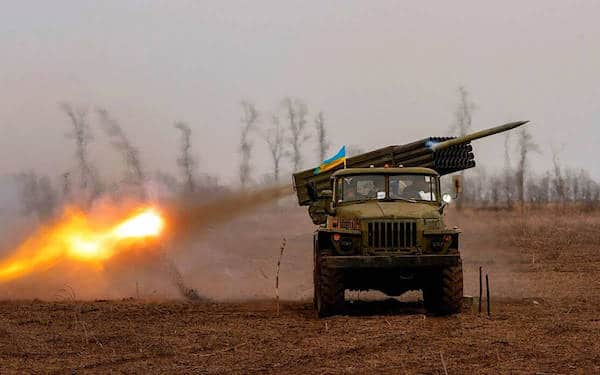 Ukrainian army terror bombardment of DPR leaves seven civilians dead and 44 injured in 48 hours
Ukrainian army terror bombardment of DPR leaves seven civilians dead and 44 injured in 48 hours
Originally published: Donbass Insider on July 6, 2022 by Christelle Néant (more by Donbass Insider) | (Posted Jul 07, 2022)
In two days, the Ukrainian army’s terror bombardment of residential areas in the Donetsk People’s Republic (DPR) has left seven civilians dead (including a 10-year-old child) and 44 injured, as well as causing widespread destruction of civilian homes and infrastructure.
Despite frequent counter-battery fire from the Russian army and the DPR People’s Militia, the Ukrainian army’s terror bombardment of civilians in Donbass continues. It seems that Ukrainian soldiers have decided to take revenge against DPR and Russian civilians for the takeover of Lisichansk by the allied forces.
On the night of 2 to 3 July, the Ukrainian army shelled the Russian city of Belgorod, located near the border with Ukraine, killing five civilians and wounding 11 others. A similar attempt against Kursk failed.
The Ukrainian army targeted purely residential areas, not military infrastructure, thus applying against Russian civilians the same terrorist methods it has used against those in the Donbass for the past eight years.
A method that it has again applied massively over the last two days. On 4 July, from 6 a.m., the Ukrainian army began shelling Gorlovka and nearby localities such as Panteleimonovka and Novobakhmutovka with mortar shells and heavy artillery. Then, at around 8 a.m., Yassinovataya, further south, and Yakolevka were shelled with 122 mm heavy artillery by Ukrainian soldiers based near Avdeyevka.
Twenty minutes later, Donetsk (Kievski district) and Makeyevka become the target of the Ukrainian army’s terror bombardments, this time from Peski, with 152 mm heavy artillery. Villages on the outskirts of Donetsk, such as Alexandrovka, are not left out, and are shelled by Ukrainian soldiers from Krasnogorovka, with 122 mm artillery.
Depuis ces mêmes positions, l’armée ukrainienne inflige de nouveaux bombardements de terreur sur le quartier Petrovsky de Donetsk, puis à nouveau sur Alexandrovka, depuis ses positions à Maryinka.
Then Gorlovka and the surrounding area were shelled again by the Ukrainian army with Grad multiple rocket launchers and 122 mm heavy artillery. At around 10 a.m., the Kirovski and Kuibyshevski districts of Donetsk were shelled by Ukrainian soldiers with 152 mm heavy artillery, followed by the Kievski district with Grad multiple rocket launchers.
Throughout the day on 4 July 2022, the terror bombardment continued towards Donetsk, Makeyevka, Alexandrovka, Elenovka, Yassinovataya and Gorlovka.
At around 11.30 a.m., the Ukrainian army again used NATO standard 155 mm guns against Makeyevka from its positions in Avdeyevka, and at around 12.40 p.m. fired eight 220 mm Hurricane rockets at the Kievski district of Donetsk.
At around 3 p.m., the Ukrainian army conducted its terror bombardment against Donetsk with NATO standard artillery from its positions in Pervomaiskoye.
The Ukrainian army’s terror bombardment did not end until 9 p.m. with the firing of 40 Grad rockets against the village of Novoselovka, near Gorlovka.
In total, on 4 July 2022, the Ukrainian army fired 731 munitions against the DPR, including eight 220mm Hurricane rockets, 166 120mm Grad rockets, 144 NATO standard 155mm shells, 183 152mm artillery shells, 157 122mm artillery shells and 73 120mm mortar shells.
The death toll from the Ukrainian army’s terror bombardment of purely residential areas of the DPR (there were no weapons, ammunition, positions or soldiers in the areas targeted by Ukrainian fire) was four civilians killed and 32 wounded, including a Russian journalist.
The market near the Donetsk railway station was completely burnt down by the intensive shelling.
As a result, people living near the railway station spent the night in the cellar of their homes to protect their children from the Ukrainian army’s terror bombing.
Russian and DPR People’s Militia artillery worked actively all day to destroy the regularly changing Ukrainian army firing positions, destroying four platoons of Grad and Hurricane multiple rocket launchers. But this was not enough to calm the Ukrainian soldiers, who continued this tactic of terror bombardment against DPR settlements on 5 July 2022.
The Ukrainian army first fired at Gorlovka and its outskirts at 3.55 a.m. with 122 mm heavy artillery. Then, at 7.45 am, Ukrainian soldiers shelled Yassinovataya with Grad multiple rocket launchers, and 10 minutes later it was again 155 mm artillery offered by NATO countries to Ukraine that was used to shell the Kievski and Kuybyshevski districts of Donetsk.
As on the previous day, the Ukrainian army’s terror bombardment then targeted several localities by changing firing positions: Alexandrovka, the Petrovsky district of Donetsk, Dolomitnoye, Panteleimonovka, and Ozerianovka.
Then at 09:40, the Ukrainian army fired 10 unguided 80 mm aerial rockets at Novobakhmutovka, but without using any aircraft (probably a DIY operation like the ones I saw a few years ago in Zaitsevo, where a mortar shell had been mounted on an RPG-type anti-tank rocket launcher rod).
At 10.45 a.m. and again at 3.30 p.m., the Ukrainian army shelled the Voroshilovsky district of Donetsk (city centre) with standard NATO 155 mm artillery. The shelling hit the beginning of Chelyuskintsev Street, where a 10-year-old girl was playing outside her house. The girl’s body was torn apart by the shrapnel. The video below shows the remains of her body and her mother, who lost her only child.
This is what the weapons that the West (including the United States and France) is sending to Ukraine are for! Not to fight the Russian army, but to shoot at purely residential areas to kill civilians, including children!
On the map below you can see all the districts in and around Donetsk that were hit by the Ukrainian army’s terror bombing on 5 July. To put it simply, only two districts escaped the shelling, which is still going on at the time of writing.
In total, the Ukrainian military fired 508 munitions into the DPR on 5 July 2022, including 98 122mm Grad rockets, 10 80mm airborne rockets, 183 NATO standard 155mm artillery shells, 42 152mm artillery shells, 64 122mm artillery shells, and 111 120mm and 82mm mortar shells.
In addition to the 10-year-old girl, the Ukrainian army fire killed two other civilians in the Kievski and Petrovski districts of Donetsk, and 12 others were injured in the capital and Alexandrovka. As on the previous day, many homes and purely civilian infrastructure were destroyed, including a car garage in Donetsk.
It is to be hoped that counter-battery fire from the Russian army and the DPR people’s militia will eventually bring an end to the Ukrainian army’s terror bombing of civilians.
https://mronline.org/2022/07/07/ukraini ... -48-hours/
*************
Reaching the Greater New York audience with common sense on Ukraine
gilbertdoctorow Uncategorized July 7, 2022
When I received an invitation from Elliot Resnick, former editor-in-chief of the Brooklyn, New York-based Jewish Press to record a podcast devoted to the Ukraine-Russia war, I was delighted to have an opportunity to address an audience that, until his untimely death eighteen months ago, my comrade-in-arms and fellow expert on Russia professor Stephen Cohen had been talking to in his weekly radio broadcasts. Of course, Cohen’s radio programs were listened to by a far wider audience than the core Orthodox community reached by The Jewish Press: they numbered in the millions. But getting a foothold in New York was desirable for me since most alternative media outlets in the U.S. reposting my essays seem to be on the West Coast.
Here is the link to the newly released podcast by Resnick:
https://open.spotify.com/episode/35r4WT ... um=desktop
Live interviews like this are always a challenge. Inevitably you do not get across every argument you prepared in advance. In my mental review of our chat, I have one regret. Though I had requested to be asked about how the Kiev regime can be fascist when its president, Zelensky, is a Jew, I did not give the most relevant answer to that question when we spoke: namely the celebration of the SS-collaborator Bandera by the ultra-nationalists running the show through Zelensky as their front man.
Bandera’s name is being given to streets throughout Ukraine and statues are raised to him. Tattoos bearing Bandera’s image were found to be worn by the Azovstal defenders when they surrendered to Russian forces.
The whole issue of Bandera and the present day heirs to Ukraine’s collaborationists during WWII was highlighted last week by the scandal over remarks to a German journalist made by the Ukrainian ambassador to Berlin, Andriy Melnyk: he denied that Bandera was anti-Semitic or was in any way responsible for the slaughter of Jews in Ukraine by his followers. Those remarks elicited a storm of criticism from the Israeli government who called it willful disinformation about the Holocaust. Official Poland also entered the fray and with good reason: Poles were slaughtered by Bandera’s warriors as well. From within Scholz’s government, Germans were incensed. Yesterday Melnyk was removed as ambassador and returned to Kiev, where he likely will be promoted to the position of deputy Minister of Foreign Affairs. This whole ugly affair is a good demonstration of the fascist nature of a government nominally headed by Zelensky.
https://gilbertdoctorow.com/2022/07/07/ ... n-ukraine/
©Gilbert Doctorow
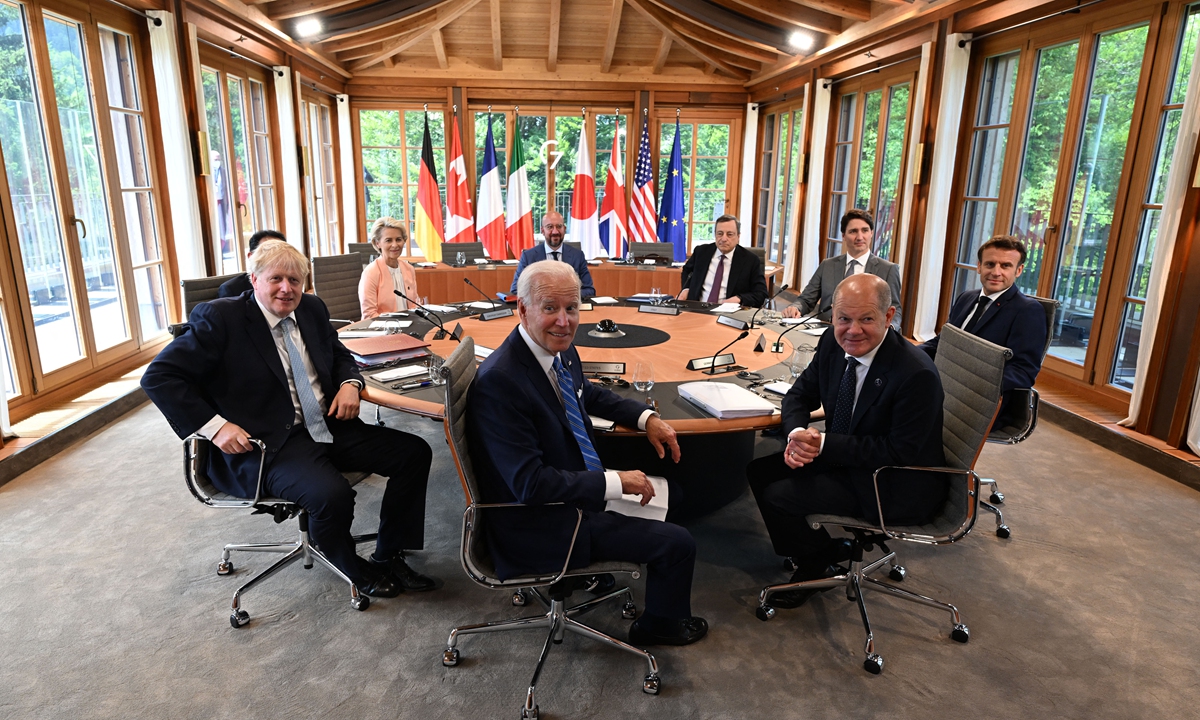
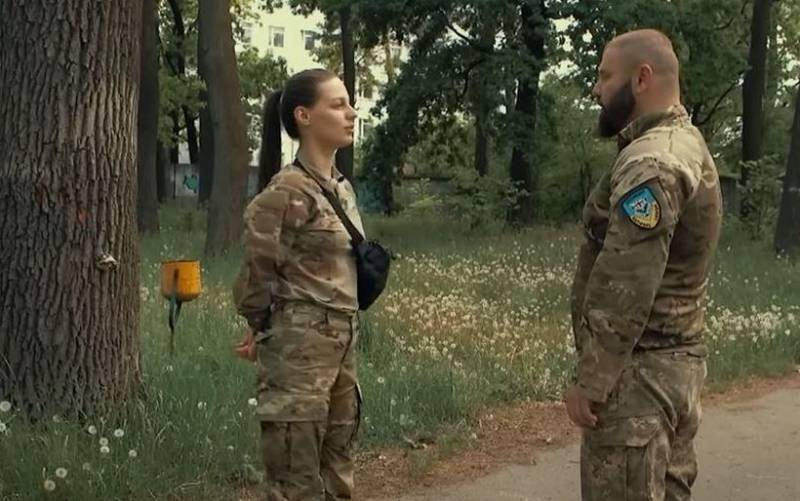


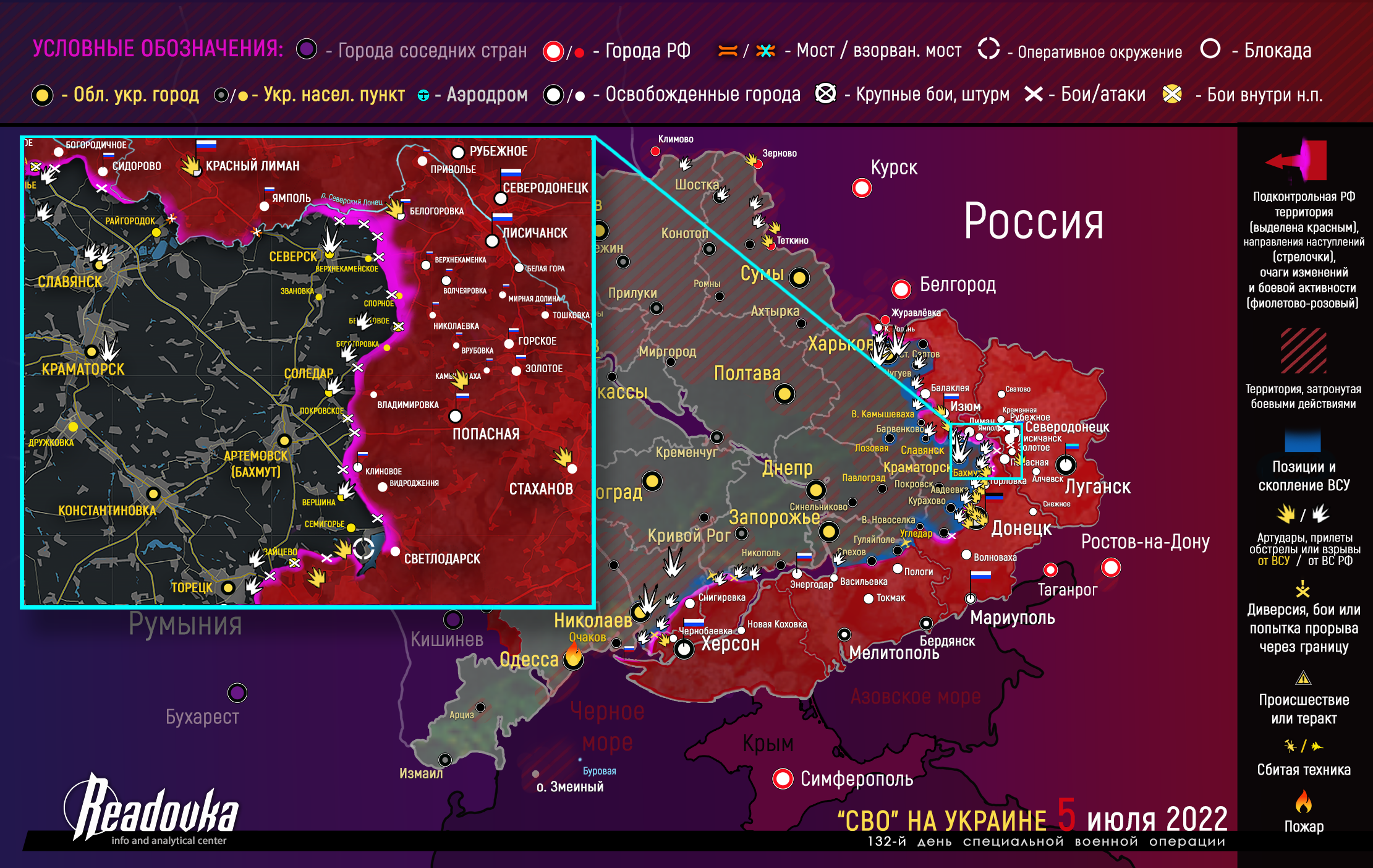



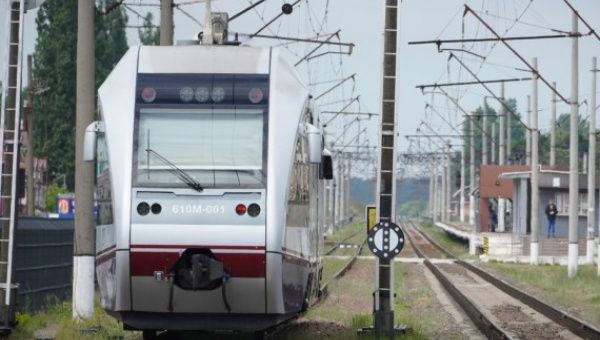

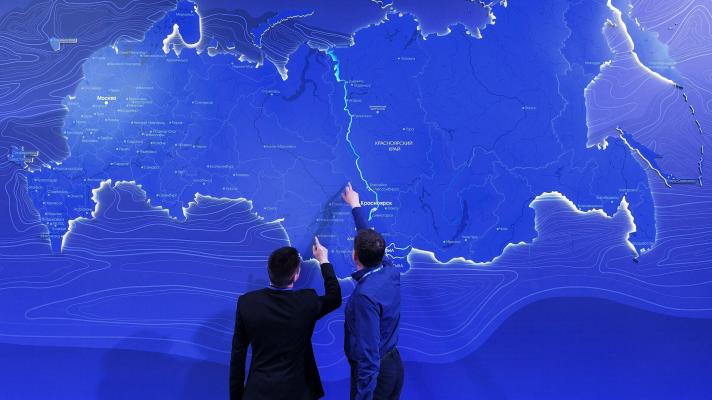
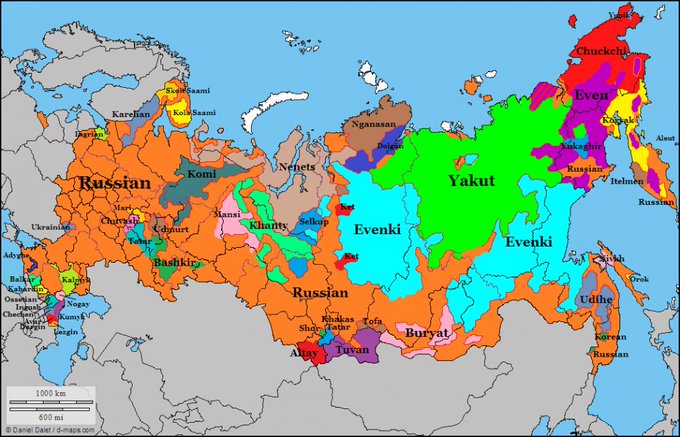
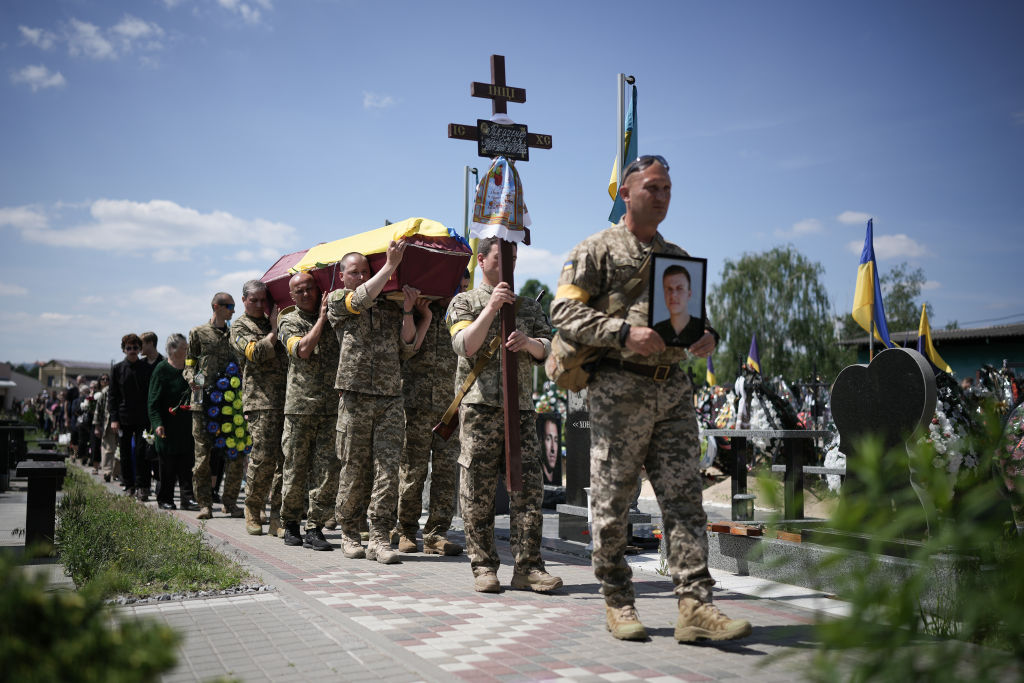

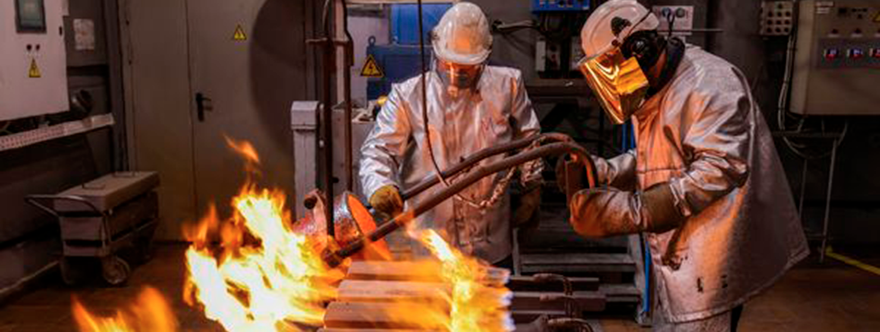
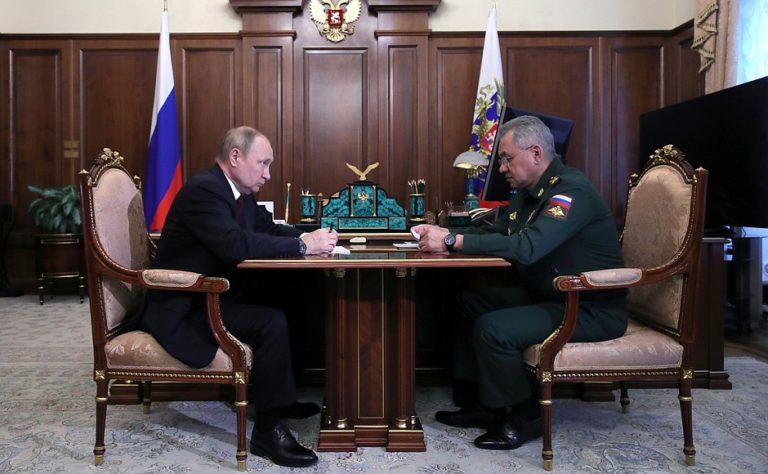
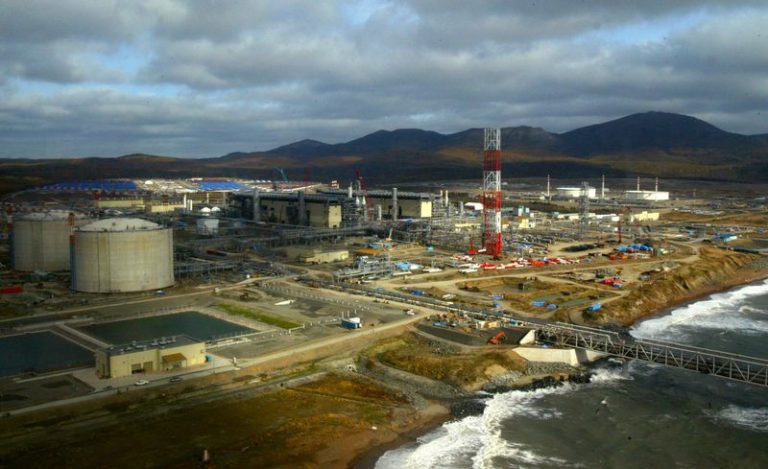
 b]
b]


